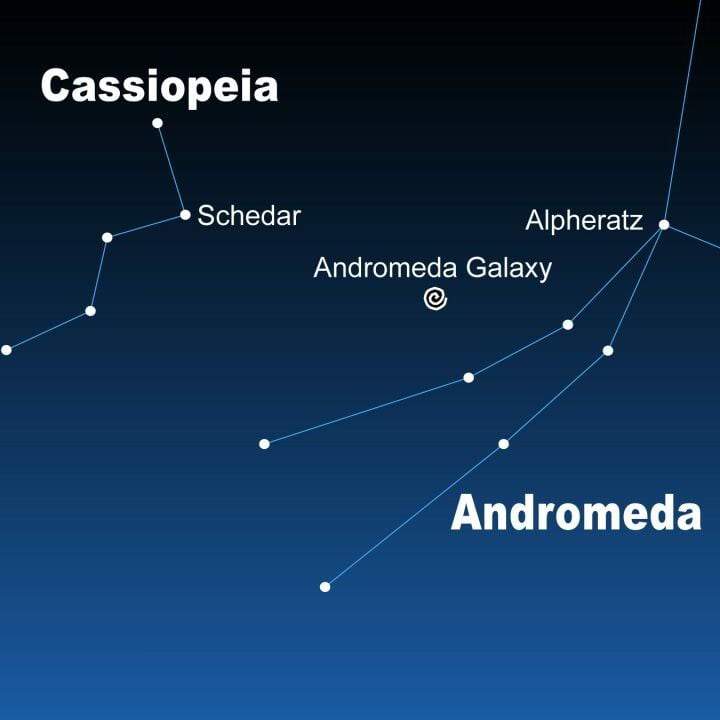How to locate the Andromeda galaxy in the starry heavens
In our recent publication, we discussed how the Andromeda galaxy, along with the Small and Large Magellanic Clouds, is one of the few galaxies that can be observed without the assistance of a telescope. Moreover, the Andromeda Galaxy holds the distinction of being the farthest object visible to the naked eye.
We have received numerous inquiries from our readers regarding the precise location and optimal viewing time for the Andromeda galaxy. In this article, we will provide you with guidance on how to locate the Andromeda galaxy in the night sky.
To catch a glimpse of the Andromeda Galaxy, you must escape the clutches of light pollution. The atmospheric scattering of light from various sources makes it challenging to spot faint objects in the night sky. Therefore, to enhance the conditions for observing Andromeda, one must seek out locations far from bustling cities, highways, and the like.
An ideal choice would be venturing into the mountains or the vastness of the steppe, several kilometers away from the nearest inhabited area. In densely populated regions of Europe, this may pose some difficulties. For the same reasons, it is advisable to observe Andromeda on nights without a moon. Moreover, of course, these observations should take place under clear, cloudless skies.
Locate Cassiopeia
To observe Andromeda, a useful guide is the constellation Cassiopeia. To find it, start by spotting the Big and Little Bears in the celestial sphere.
Cassiopeia can be found on the opposite side of Polaris, across from the Big Dipper. It stands out due to its distinctive arrangement of five bright stars forming a W shape.
Discover the constellation Pegasus
In close proximity to Cassiopeia, you will easily locate the constellation Pegasus and the neighboring constellation Andromeda. Pegasus can be easily identified by its prominent stars that form a nearly square-shaped quadrangle.
The Andromeda Galaxy can be found near the constellation Andromeda. The simplest way to locate it is to imagine a straight line passing through the stars Mirach and Mu Andromeda.
The Andromeda Galaxy is positioned along this straight line, between the constellations Pegasus, Andromeda, and Cassiopeia. It will appear as a slightly blurry and elongated spot.
If you direct an amateur telescope towards it, you may be able to observe small spots on its sides: these are the dwarf Andromeda satellite galaxies, M32 and NGC 205.
Also, check out: How close can stars be to each other
Written by: Ph. Alexander Petrov, astrophysicist Fyodor Karasenko
Make sure to subscribe to my channel here, as well as to my YouTube channel . Every week, I upload videos where I answer questions about space, physics, futurology, and more!
The Andromeda Galaxy, also known as M31 or the Andromeda Nebula, stands out as one of the most distant celestial objects observable to the unaided eye. Its location in the sky can be identified by the arrangement of the surrounding constellations. Although this galaxy is barely perceptible to the naked eye, it is advisable to utilize binoculars or a telescope for a better view. The optimal time for observation is during a dark fall or winter night. While initially challenging to locate, once found, its position is unlikely to be forgotten.


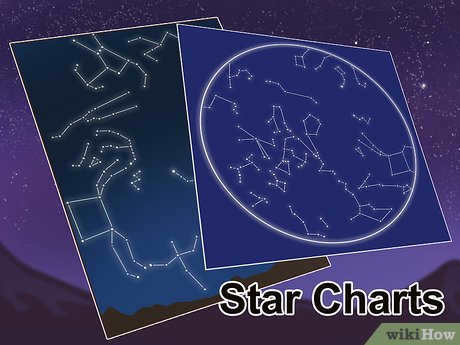
Use a star map to locate the galaxy. The positions of galaxies, stars, and constellations can vary depending on the time of year. Find a star chart for the current month. [3]
- You can find free star maps on the internet. Additionally, these maps are sometimes available for purchase at planetariums and astronomical societies.
- A star map will provide information on the optimal time to search for the Andromeda galaxy based on the time of year.
- For instance, in September and October in the Northern Hemisphere, the Andromeda galaxy ascends in the east and should be directly above you by midnight. [4]
- If you reside in the Southern Hemisphere, you should search for the Andromeda galaxy towards the northern part of the horizon in December. In the Southern Hemisphere, this galaxy may not rise very high above the horizon. [5]

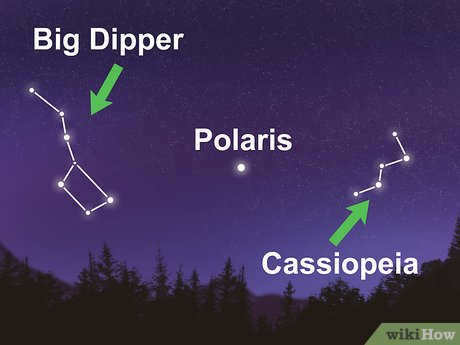
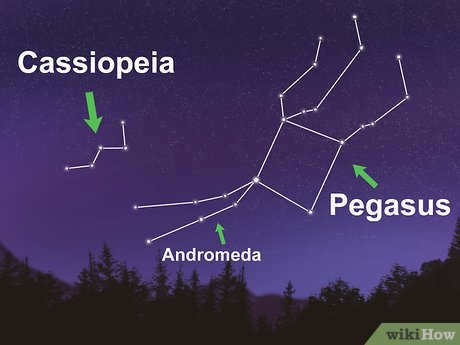
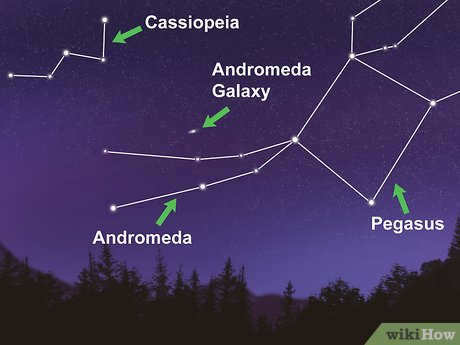
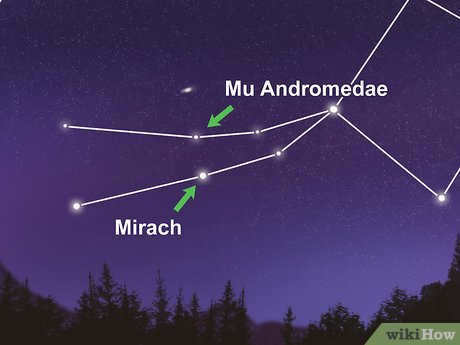
- Mirach is brighter than Andromeda’s Mu and is further away than other visible stars from the Andromeda Nebula.
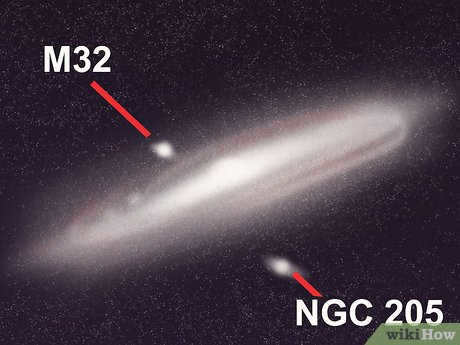


- Regular binoculars are suitable for use. The most optimal binoculars have lenses with magnifications of 7×50, 8×40, or 10×50. [11]
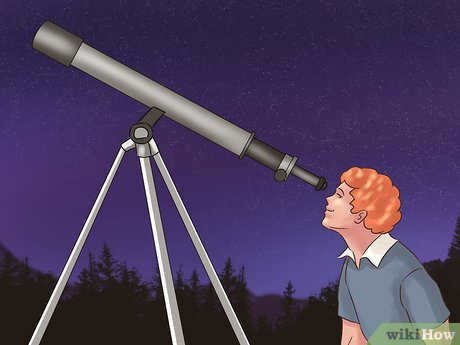
If you want to get more information, utilize a telescope. A regular 20-centimeter reflector telescope will permit you to observe the core (or middle) of the galaxy, along with two accompanying galaxies. The size of the Andromeda Galaxy is so immense that it might not completely fit within the telescope’s field of vision. [12]
- When using a telescope, adjust it to the lowest possible magnification. Although the Andromeda Galaxy may appear quite small when attempting to see it with the naked eye, it will appear very large when viewed through a telescope.

- The Andromeda galaxy is visible year-round in the Northern Hemisphere, although its visibility may be reduced in certain months. [14]


Opt for a night without the moon. The presence of the moon can hinder your ability to observe the stars. To locate the Andromeda Galaxy in the sky, it is recommended to choose a night when there is no moon or when the moon is in its waning phase. [15]
- During a full moon, it will be challenging to locate the Andromeda galaxy.
- A new moon occurs once a month. Look for a lunar calendar online to determine the best night for stargazing.
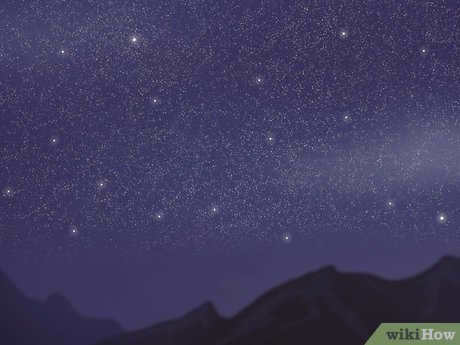

- The galaxy’s outer arms are barely visible, so what you’re actually seeing is the core. To capture the full beauty of the galaxy, you can take a photograph using a long shutter speed, a camera attachment, and an image-matching program like RegiStax or ImagesPlus.
- Remember to dress appropriately for the weather, especially during the winter season.
About this article
This article has been accessed 80,436 times.
Did you find this article helpful?
The Andromeda Galaxy, also known as Messier 31 or “the Great Spiral Galaxy,” is one of the most distant celestial objects visible to the naked eye. To locate its position in the sky, you can use the surrounding constellations. While it is faintly visible to the naked eye, using binoculars or a telescope will provide a clearer view. For the best visibility, it is recommended to observe it on a dark night during autumn or winter. Initially, finding it may be a bit challenging, but once you locate it, it becomes easier to find again.

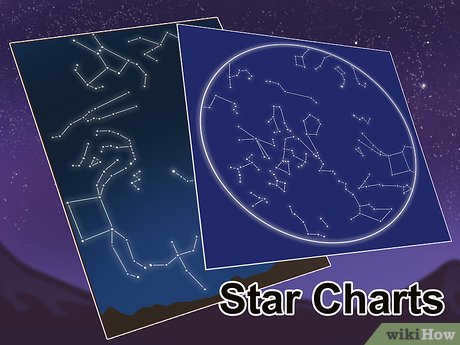
- Star charts are available for free on the internet. They can also be purchased at planetariums or from astronomical societies.
- The star chart can also provide information on the best time of night to view the Andromeda Galaxy based on the season.
- For instance, during September and October, the Andromeda Galaxy can be seen rising in the eastern sky of the northern hemisphere. By midnight, it should be directly overhead. [3]
- If you are located in the southern hemisphere, you can look towards the northern horizon in December to catch a glimpse of it. However, it may not be very high in the sky. [4]

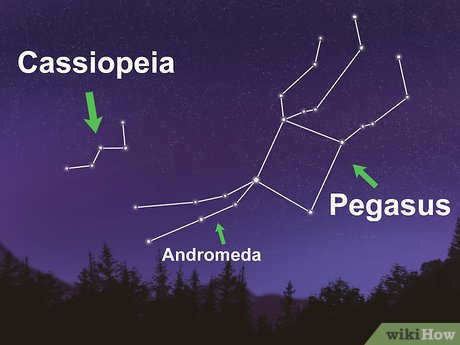
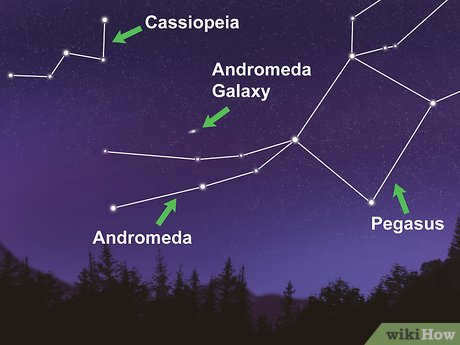
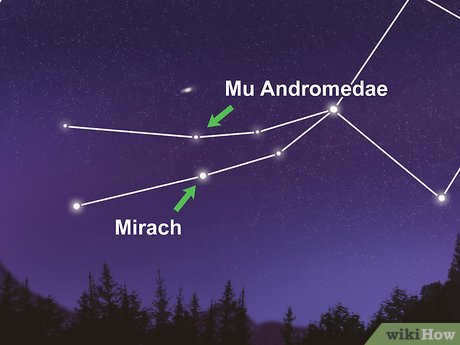
Trace a line crossing out the Mirach and Mu Andromedae stars. Commence at the star in the top left corner of Pegasus. This is where the constellation Andromeda commences. Proceed downwards along Andromeda, passing two stars. You will come across two stars stacked on top of each other known as Mirach and Mu Andromedae. If you draw a line through these two stars and extend it beyond Mu Andromedae, you will eventually reach the Andromeda Galaxy. [7]
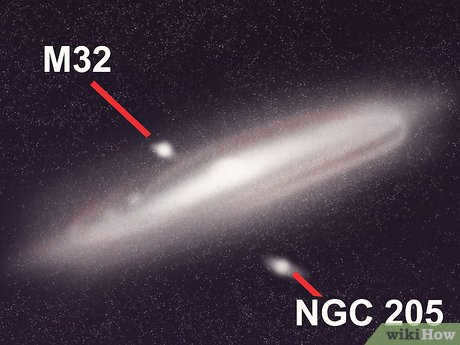
1 To begin, try using your naked eye to locate the galaxy. The Andromeda Galaxy is visible without the need for any special equipment. It will appear as a dim, hazy oval in the night sky. Once you have identified the general region of the sky where the galaxy is situated, it might be simpler to spot it using a pair of binoculars or a telescope. [9]

- To locate the Andromeda Galaxy, you have the option of utilizing regular binoculars. The most suitable binoculars for this task would possess lenses with dimensions of 7×50, 8×40, or 10×50. [11]
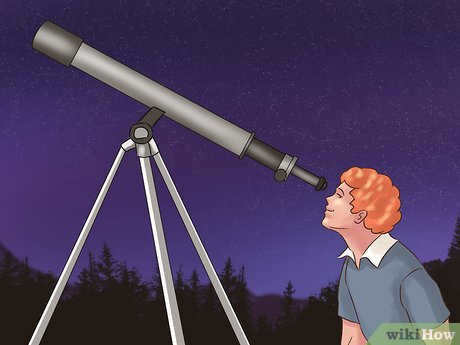
- When using a telescope, it is advised to keep it at the lowest magnification settings. Although the Andromeda Galaxy may seem small to the naked eye, it will appear significantly larger when observed through a telescope.

- Throughout the year, the Andromeda Galaxy can be observed in the northern hemisphere, although it may be more challenging to locate in different seasons. [14]

- Locating the Andromeda Galaxy can be challenging when the moon is in its full phase.
- Every month, there is a new moon. To determine the optimal night for observing the stars this month, consult an online lunar calendar.
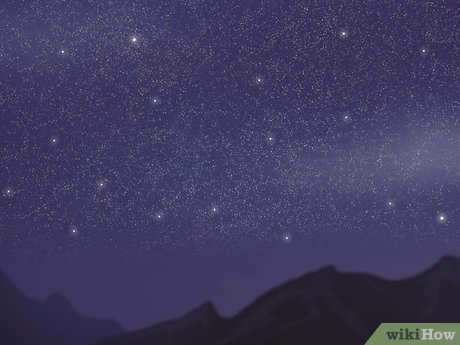
When searching for the Andromeda Galaxy, it is possible to spot it in Egypt, although it might be easier to locate it in the northern regions of the country rather than the southern areas.
To locate the Andromeda Galaxy, look for the three stars that form the Summer Triangle: Deneb, Altair, and Vega. The Dumbbell Nebula is situated at the center of this triangle.
Remember to include your email address so that you can receive a notification when your question is answered.
What you will actually observe is the core of the galaxy, as the outer arms are quite faint. If you want to capture an image of it, you may need to use a long exposure time, a camera adapter, and image stacking software like Registax or ImagesPlus.
Thank you for sharing your tip for review!
About This Article
If you want to locate the Andromeda Galaxy, you can do so by observing the sky in the months of August and September in the northern hemisphere, or October and December in the southern hemisphere. It is best to choose a night when there are no clouds and the moon is not visible, as this will make the Andromeda Galaxy more visible. Start your search by locating the Cassiopeia constellation, which can be identified by its «w» shape and is situated near the north star. Next, find the Pegasus constellation, which appears as a large rectangle. Finally, you will find the Andromeda Galaxy as a hazy oval between the Cassiopeia and Pegasus constellations. If you would like to learn more about using a star chart or a stargazing app to find the Andromeda Galaxy, continue reading below!
Did this summary assist you?
Special thanks to the authors of this article for providing valuable information that has been accessed 846,194 times.
Did this piece of writing assist you?
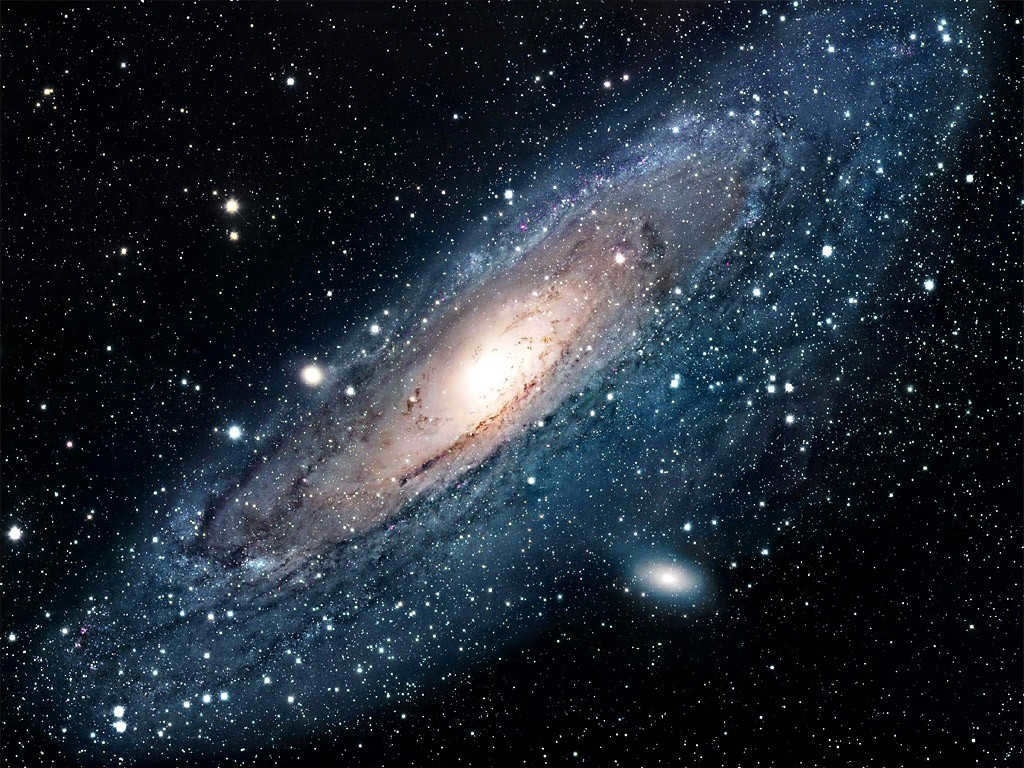

Despite its vast distance of 2.54 million light years, the Andromeda galaxy maintains an apparent stellar magnitude of 3.44 and occupies a linear size of 3.167×1 degrees in the celestial sphere, making it visible to the naked eye as a slightly elongated spot in the sky. This can be attributed to the fact that Andromeda boasts a trillion stars, surpassing the Milky Way in size by at least 2.5 times and earning the title of the largest galaxy in the Local Group. Nevertheless, despite its immense stellar population, it still falls short in brightness compared to approximately 150 stars in both the northern and southern hemispheres of the night sky.
Observation
To locate the Andromeda Galaxy, it is recommended to begin the search from the easily identifiable Polaris and then navigate through the constellations of Cassiopeia or Pegasus.
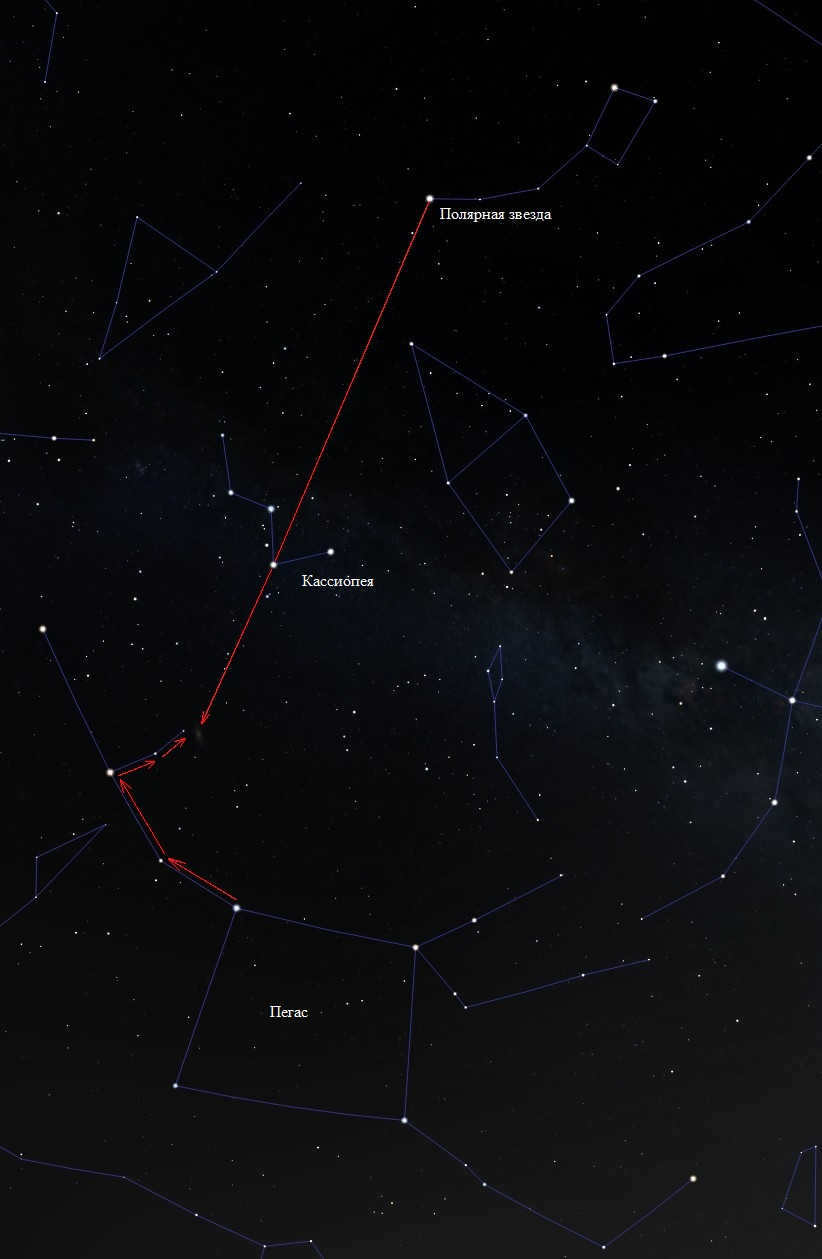
The position of the Andromeda Galaxy in the night sky
Located in the constellation Pegasus: To locate the Andromeda Galaxy, we need to follow the constellation Pegasus until we reach Alferac, which is the brightest star in the constellation Andromeda. From Alferac, we then move to Mirach and make a 90-degree turn to search for two other prominent stars in this constellation. Just beyond the second of these stars, we will find the Andromeda Galaxy.
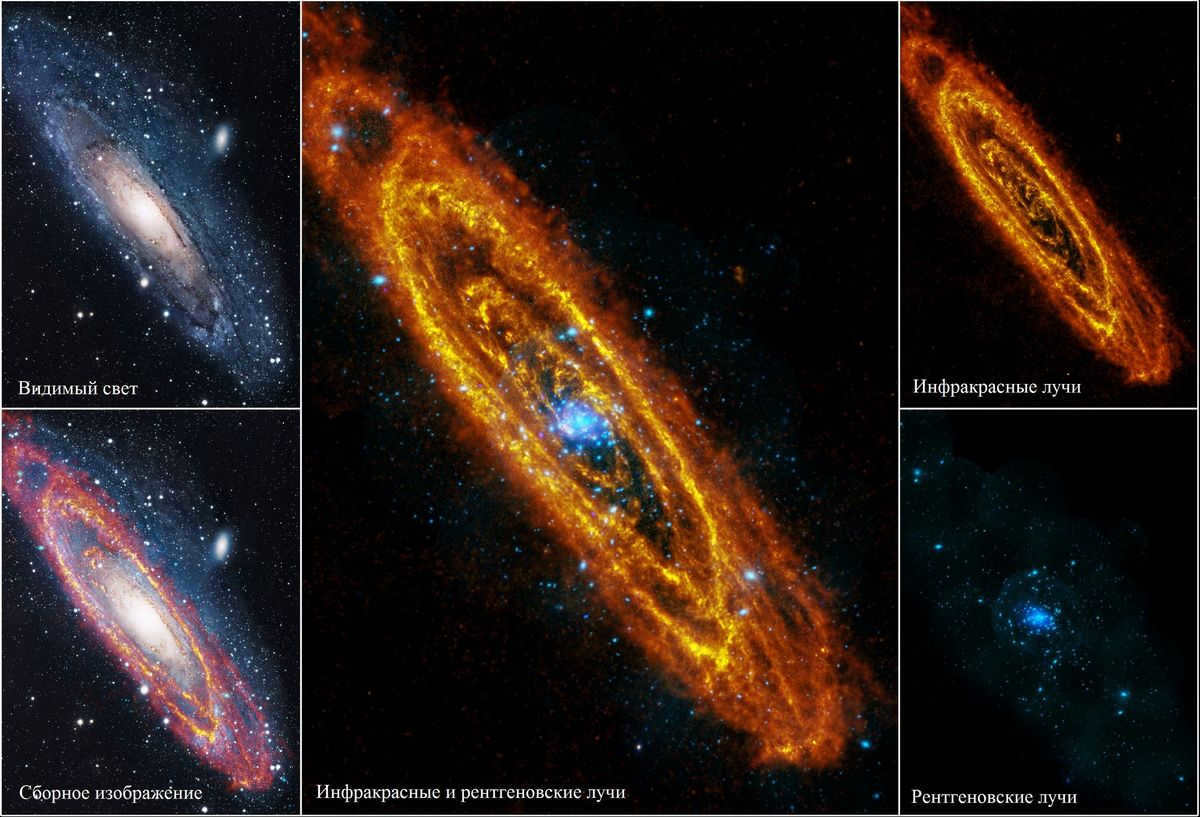
The Andromeda Galaxy as seen in various sections of the electromagnetic spectrum
History of Observation
Since this galaxy is visible to the naked eye, it has been referenced as early as 946 AD. However, it was not until the development of modern telescopes that individual stars could be distinguished, revealing the true nature of this object. Initially, it was mistaken for a small nebula in our own galaxy. The first indications of its extragalactic origin came from spectral analysis conducted in 1912, which showed that it was moving towards us at a speed of 300 km/s. The discovery of a supernova explosion in 1917 provided an approximate estimate of its distance – 500,000 light-years. However, it was Edwin Hubble who ultimately settled the debate among scientists.

The Andromeda galaxy captured by the Hubble telescope
The advanced capabilities of modern telescopes have made it possible to observe individual stars within the Andromeda galaxy. In early 2015, a photograph was released that spanned 61 thousand light-years of Andromeda, revealing over 100 million stars. To create this image, the Hubble telescope took a total of 7,398 individual pictures, which were later stitched together to form this mosaic.
How to locate the Andromeda Nebula in the celestial sphere?
Published on 17.11.2018 –
Comments: 0
·
Reading time: 5 min
·
Views:
A week ago, we embarked on a quest to find the Andromeda constellation in the night sky (hopefully with success). Now, let us endeavor to spot what intrigues beginner stargazers the most in this constellation – the Andromeda Nebula. The Andromeda Nebula. So, how can we locate the Andromeda Nebula in the starry expanse?
- 1 What shall we be searching for?
- 2 Identifying the Andromeda Nebula in the night sky
- 3 How to find the Andromeda Nebula in the sky. Method #1
- 4 How to find the Andromeda Nebula in the sky. Method № 2
- 4.1 What should we do if the Andromeda Nebula is not visible?
What is our objective?
Prior to commencing our search, it is important to note that the Andromeda Nebula, or rather the Andromeda Nebula as it is commonly referred to, is not actually a nebula. In contrast to the Orion Nebula, which is a cloud of interstellar gas, the Andromeda Nebula is a colossal galaxy, even surpassing our own Milky Way in size. Recent estimations indicate that the Andromeda Nebula is home to approximately 1,000 billion stars, with around one in every 20 of these stars sharing similar characteristics to our Sun.
So why was the Andromeda Nebula given this name? The reasoning behind this dates back to a time when astronomers referred to any faint, indistinct object in the telescope that couldn’t be resolved into separate stars as a nebula. These objects appeared similar to clouds or parts of the Milky Way. Eventually, it was discovered that some of these objects were actually distant star clusters, while others were interstellar gas clouds, and still others were massive galaxies located very far away. However, the general term “nebula” stuck and continues to be used today, even though it is quickly becoming outdated.
When capturing images, the Andromeda Nebula presents itself in this manner:
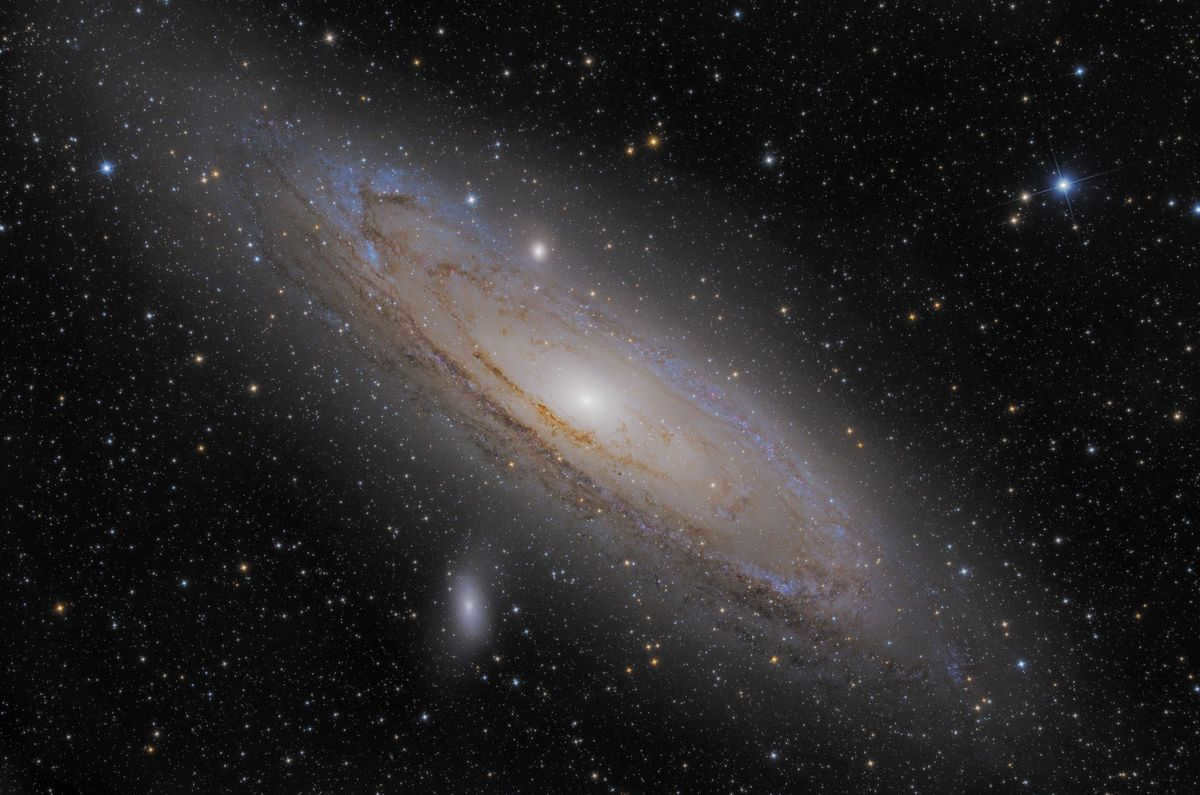
Richard Sweeney captured the Andromeda Galaxy (M31) using his Asi 071 equipment and Takahashi Epsilon 130 telescope. The total exposure time for this photo was 5.4 hours.
Have you ever wondered how the Andromeda Nebula appears in the night sky?
Andromeda Nebula: A Unique View in the Night Sky
The appearance of M31 in the night sky can vary depending on the location, time, and viewing conditions. There are three key factors that greatly impact the visibility and clarity of this celestial wonder:
- Light Pollution: Urban areas have long been plagued by excessive artificial lighting, which effectively conceals faint stars, nebulae, and even the majestic Milky Way from city-dwellers. Additionally, the presence of smog often lingers above metropolitan areas, further diffusing the glow of streetlights and transforming a seemingly clear sky into a milky haze.
- Overall sky conditions. Even when you are away from the city and its artificial lights, the appearance of the sky may not be significant. What truly matters is not the tranquility of the atmosphere, but its level of transparency. The greater the transparency and clarity of the sky overhead, the more faint objects you will be able to observe within it.
Assume you are located outside the city, or at least on the outskirts, and the sky above you is relatively dark and clear. There are two methods for locating the Andromeda Galaxy in the nighttime sky.
Discovering the Andromeda Nebula in the sky: Approach #1
One way to locate the Andromeda Nebula is to start by identifying a prominent group of stars known as the Pegasus Square.
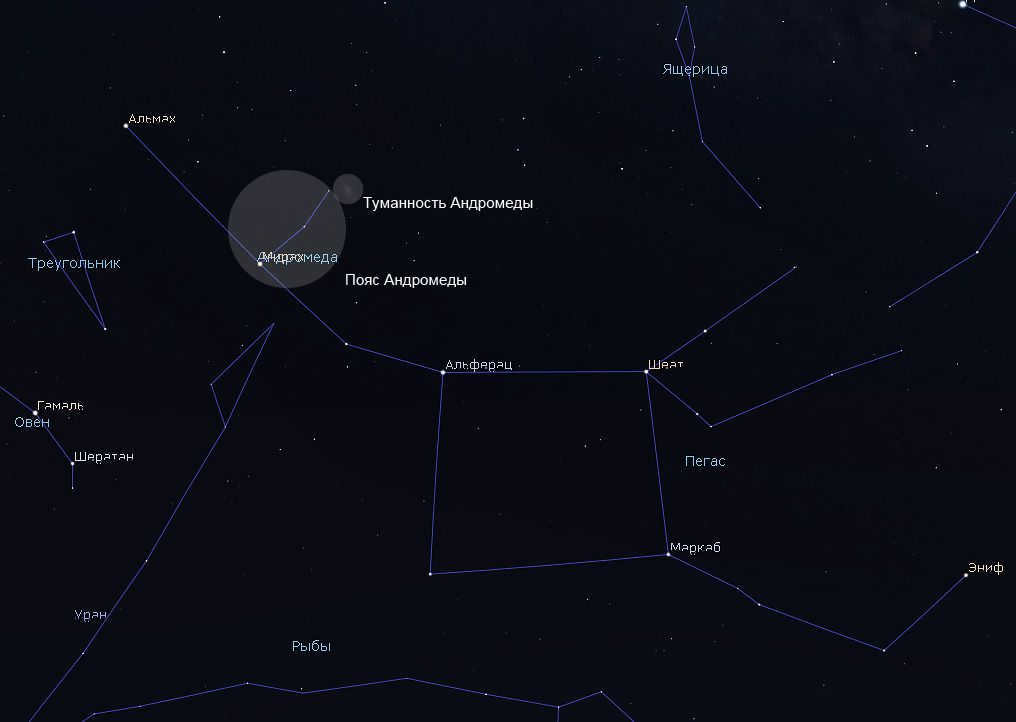

The large square of Pegasus can easily be spotted on autumn nights – just look south and tilt your head up. The stars that form the square are not particularly bright, but their brilliance is comparable to the stars of the famous Big Dipper. Since the surrounding stars are also not very bright, the Square of Pegasus stands out prominently in the evening sky during the second half of autumn.
Once you have located the square of Pegasus in the night sky, it becomes effortless to identify the key stars that compose the shape of Andromeda. It is important to note that the fundamental configuration of this constellation is a succession of stars, which extends in a diagonal manner from the top left corner of the Pegasus square towards the east. During the evenings in November, Andromeda can be observed at a considerable altitude in the sky, and when combined with the square, it forms a resemblance to a colossal smoking pipe and its mouthpiece.
Throughout the month of November, Andromeda can be seen positioned at a substantial height in the night sky.
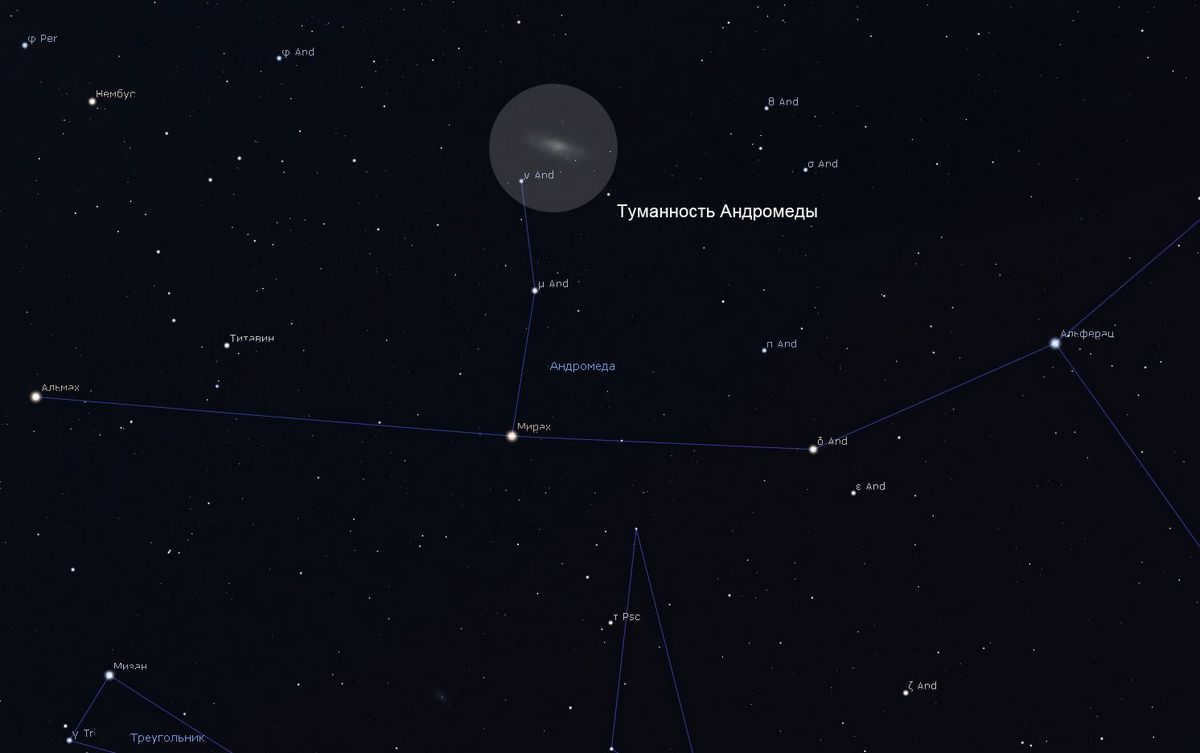
The Andromeda Nebula can be located directly above the star ν Andromeda. Image: Stellarium
A Guide to Locating the Andromeda Nebula in the Night Sky – Method #2
Alternatively, we can locate the Andromeda Nebula not from the square of Pegasus, but by using the constellation Cassiopeia, which is positioned near the zenith during autumn evenings.
The constellation Cassiopeia is easily identifiable due to its distinct letter formation in the sky, resembling a “W” or an “M”. To spot Cassiopeia in the fall, simply step outside and gaze upwards.
Have you found the constellation? Now observe that the right side of the celestial letter formation is more pronounced than the left side. This sharper half of the constellation points directly towards the Andromeda galaxy.
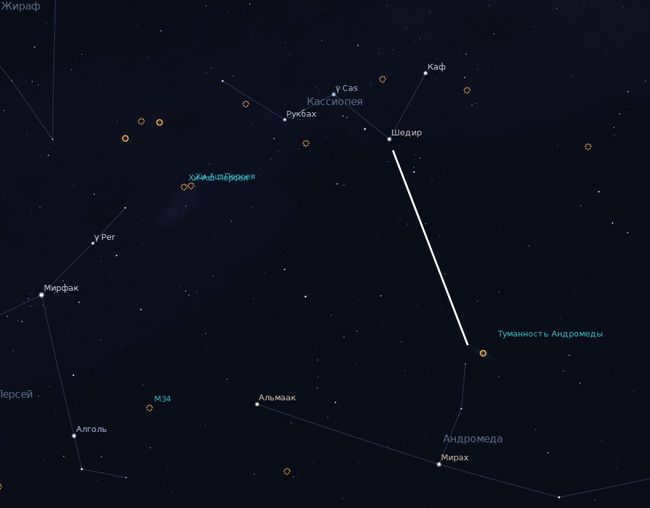

Utilize the precise, more defined portion of the letter W as a celestial indicator directing towards the Andromeda Nebula. Illustration: Stellarium
The measurement from the tip of the indicator to the nebula is roughly 4 times the space between the adjacent stars that constitute the letter W of Cassiopeia.
What to do if you can’t see the Andromeda Nebula?
If the Andromeda Nebula is not visible to the naked eye, you can attempt to locate it using binoculars or a telescope.
Binoculars provide a wider field of view, making it easier to spot the galaxy. Begin your search from the star Mirach (beta Andromeda), then navigate your binoculars through the mu and nu of Andromeda. In urban skies, the nebula will appear as a faint spot just above and to the right of Andromeda’s nu. Take your time and carefully survey this area of the sky. It is only when you are outside the city that the soft glow of the galaxy will become truly noticeable.
When searching for objects in the telescope, it is recommended to start with the star Mirach and then move successively through mu and nu Andromeda. It is important to use the lowest magnification possible in order to increase the field of view. High magnifications are not necessary for observing galaxies and faint nebulae, as they can actually reduce contrast. If you own a Newtonian telescope, it is important to note that it produces an inverted image. However, if you have a Go To telescope, you can simply type the name of the nebula into the computer and the telescope will automatically point to it.
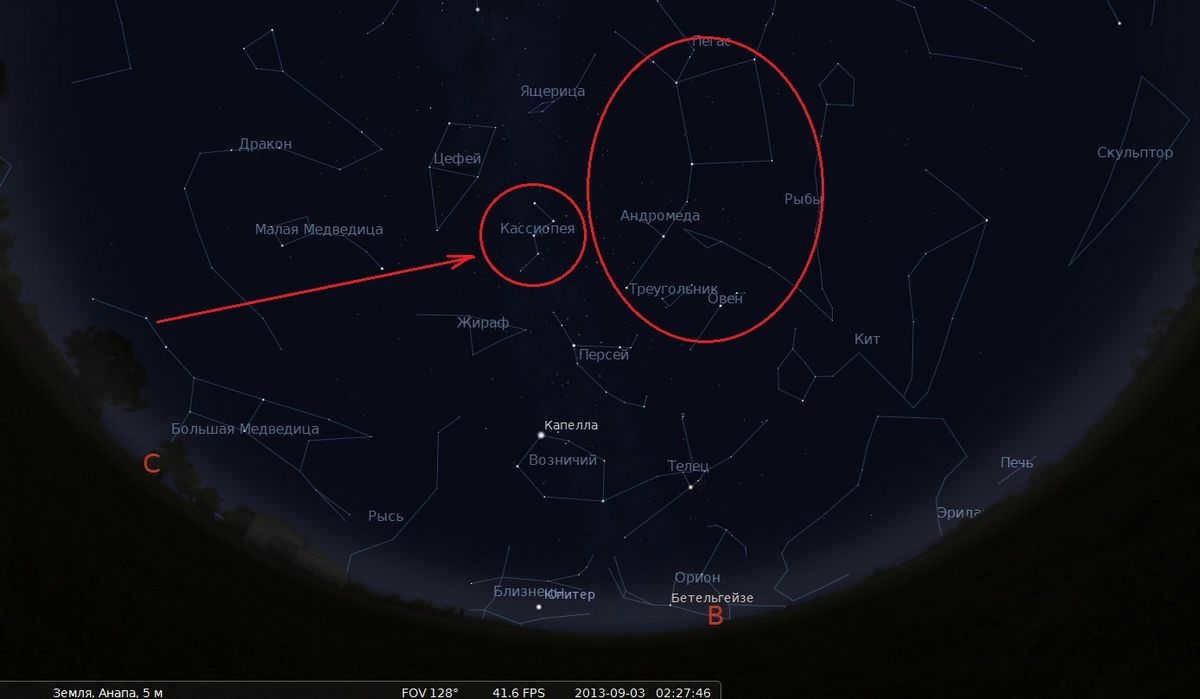
Next, make a right turn towards the southeast part of the celestial dome, where we can observe two prominent constellations, namely Andromeda and Pegasus, situated below Cassiopeia. A notable aspect here is the presence of the “Square of Pegasus,” which consists of four stars arranged in a square shape.
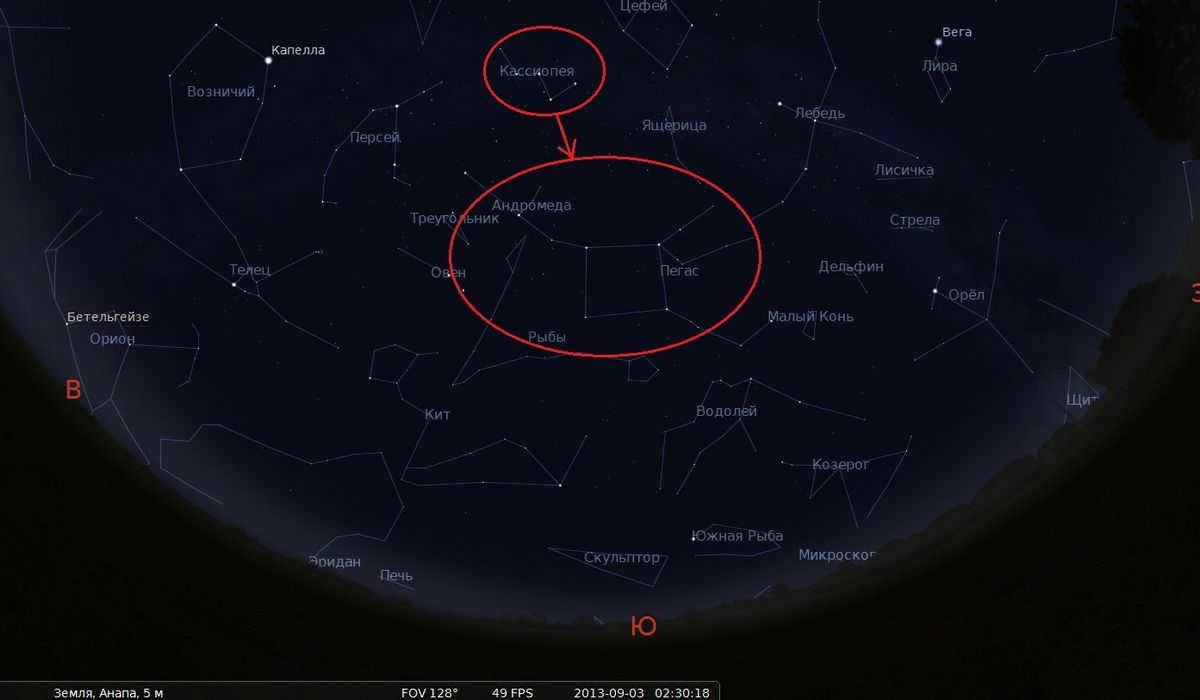
To locate it, we can use it as a reference point and trace an imaginary line along the stars to the left and then upwards. If you follow these steps correctly and observe the area with binoculars, a telescope, or a reliable optical finder, you will be able to spot a small luminous oval cloud. Congratulations, you have found the Andromeda Nebula – a vast galaxy that our Galaxy is currently approaching (the collision will occur in approximately 3-4 billion years).
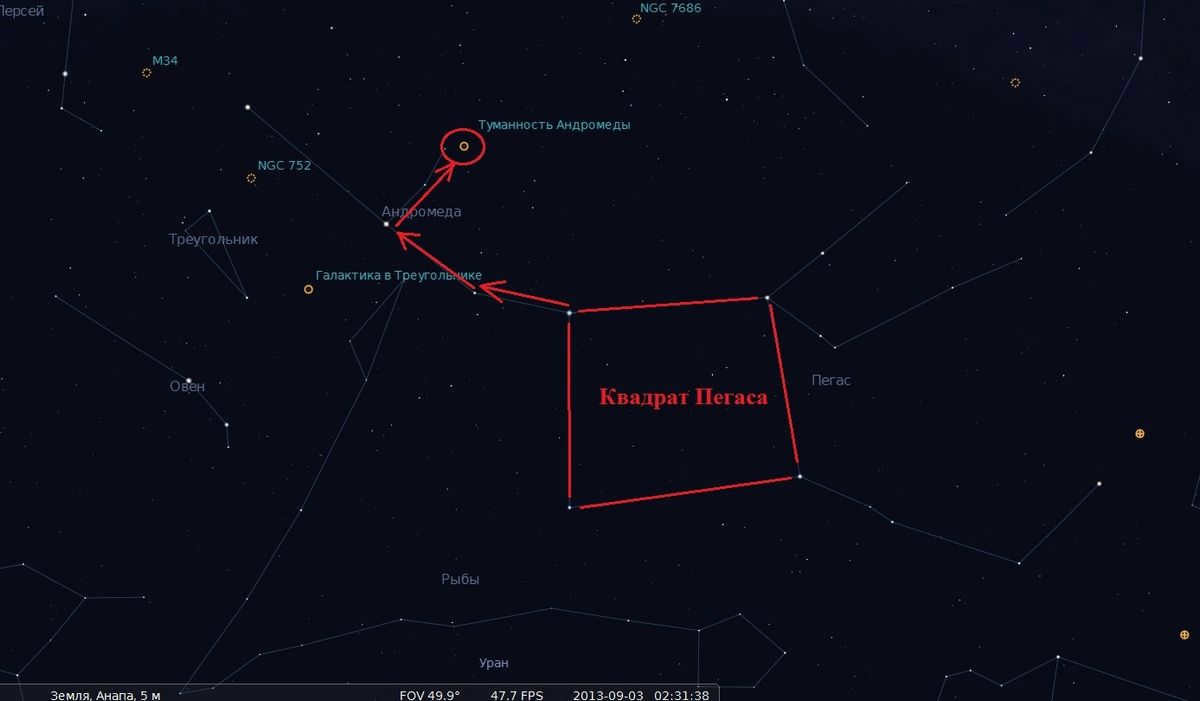
When using small telescopes, the Andromeda Nebula can be seen in a similar way to binoculars, but larger telescopes reveal a large oval shape. Additionally, some of its satellites, such as M32 and M110, can also be observed. With 20×60 binoculars, the Nebula can be seen across the entire field of view. In terms of visual size, the Andromeda Nebula measures about 3…3.5 degrees, which is 7 times the apparent size of the Moon! Larger telescopes with diameters of 250mm or more allow for the observation of dust tracks near the center of the galaxy. To ensure successful observations, it is important to have a dark sky and minimal light pollution.
The Andromeda Nebula appears even more stunning in images compared to visual observation, primarily because of the visibility of dust clouds along the galaxy’s center. Even with a basic motorized equatorial mount and a DSLR camera with a kit lens, it is possible to capture beautiful images of the galaxy.
(I hope that I have succeeded), and now let’s attempt to locate in the vast expanse of the night sky that which has captivated the interest of aspiring astronomers – the Andromeda Galaxy. So, how can you spot the Andromeda Galaxy amidst the stars?
First and foremost, it is important to note that the Andromeda Galaxy is not actually a nebula. In other words, it is not a cloud of interstellar gas resembling the Orion Nebula. Rather, it is a colossal galaxy similar to our own Milky Way, and in fact, even larger. Recent estimates suggest that the Andromeda Galaxy is home to approximately one trillion stars, with about one in every 20 stars sharing similar characteristics with our Sun.
The Andromeda Nebula is officially known by different designations. The most well-known designations for it are M31 (which is object number 31 in Charles Messier’s catalog) and NGC 224 (which is the 224th object in the New General Catalog of Nebular Objects). So, it’s not unusual to come across the names “M31,” “NGC 224,” or “Andromeda Galaxy” when referring to the Andromeda Nebula.
In high-quality photographs, the Andromeda Nebula appears like this:
Andromeda Galaxy (M31). Captured using Asi 071 equipment, Takahashi Epsilon 130 telescope, with a total exposure time of 5.4 hours. Photo taken by Richard Sweeney.
But how does the Andromeda Nebula actually appear in the sky? It depends on where, when, and how you observe it. There are three main factors that greatly affect the visual experience:
- Sky brightness. Urban areas have historically been centers of intense artificial lighting, with streetlights illuminating the streets so brightly that they have effectively obscured the visibility of faint stars, as well as nebulae or the Milky Way, for city residents. Additionally, the presence of smog often lingers over large cities, scattering the light emitted by streetlights and transforming even a cloudless sky into a hazy glow.
- Elevation of the Andromeda Nebula. The galaxy is challenging to observe during sunrise and sunset due to significant atmospheric absorption of light near the horizon. The most favorable conditions for observing the galaxy occur during the months of August and September, as well as the evenings in October, November, and December, when the galaxy reaches its highest point in the sky.
- The overall condition of the sky. Even when you are away from the city, away from the lights of the streets, the sky may not be significant. What truly matters is not the tranquility of the atmosphere, but its level of transparency. The greater the transparency and clarity of the sky above you, the more faint objects you will be able to observe within it.
Imagine you are outside the city, or at least on the outskirts of the city, and the sky above you is relatively dark and clear. There are two methods to locate the Andromeda galaxy in the nighttime sky.
Locating the Andromeda Nebula in the Sky: Method #1
When it comes to finding the Andromeda Nebula, one effective approach is to start your search from the null point, which is a prominent constellation known as the Square of Pegasus.
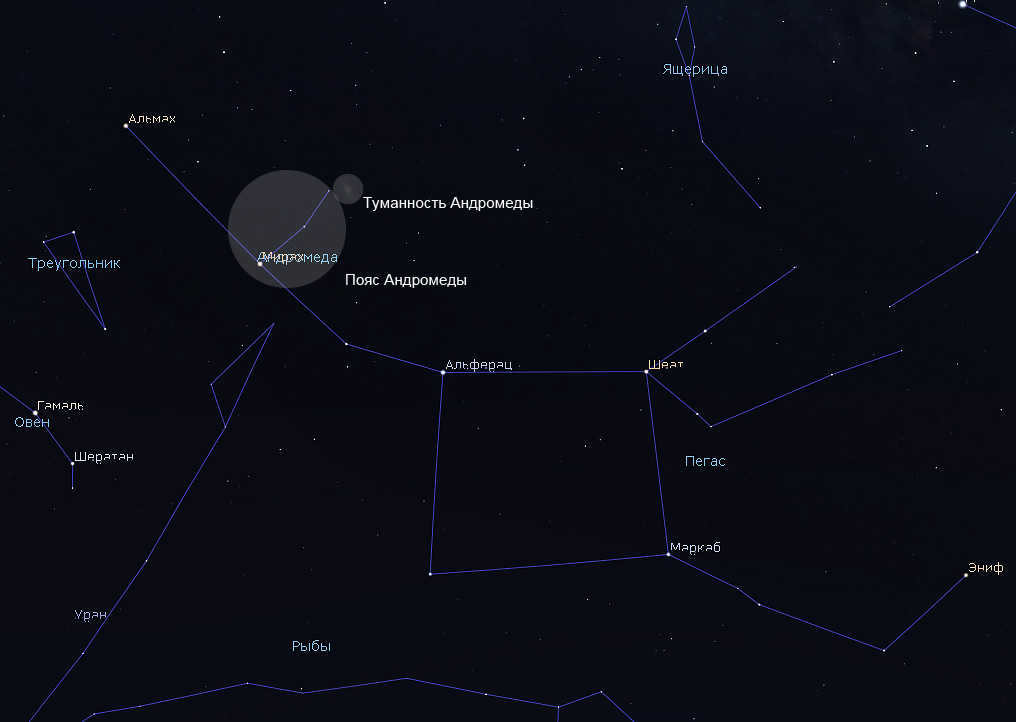
The vast square of Pegasus and the constellation Andromeda, positioned next to the square on its left side. Image: Stellarium
During the autumn season, it can be quite challenging to locate the Square of Pegasus – however, it will easily catch your attention if you face towards the south and look upward. The stars that form the square do not possess a high level of brightness – their luminosity is comparable to the stars found in the well-known Big Dipper’s handle. Nevertheless, due to the surrounding stars also lacking brilliance, the Square of Pegasus truly stands out in the depiction of the night sky during the latter part of autumn.
In the evenings of November, Andromeda can be seen at a very high position in the sky.
Now take a look at the star in the middle of the constellation. This particular star is known as Andromeda’s β, or Mirach. (Having trouble with the Greek letters? Check out the Alphabet.) Above Mirach, you will be able to spot two relatively faint stars, μ and ν, which are part of Andromeda. Together, these three stars create what is known as the Andromeda belt. (Interestingly, on medieval maps, the mythological heroine is depicted as being chained to a rock, but for some reason, she is positioned horizontally!) Therefore, the Andromeda Nebula can be found just above the belt, specifically above the star ν in Andromeda!
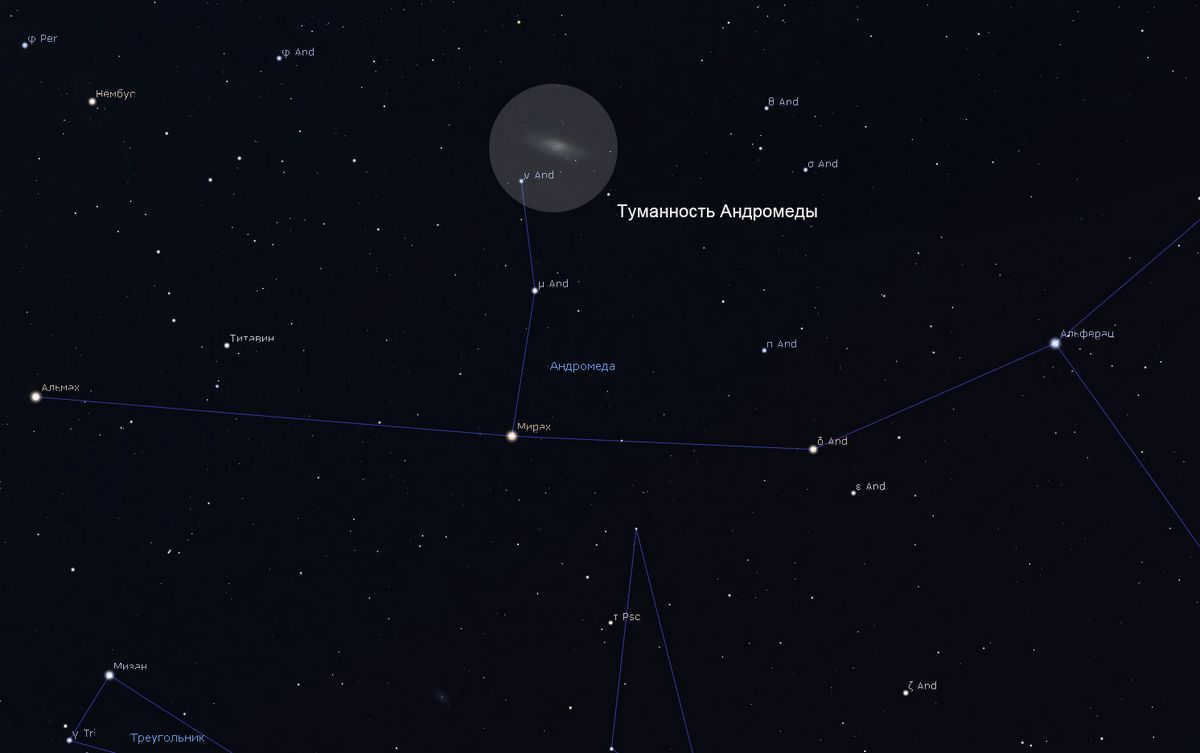
The Andromeda Galaxy can be located directly above the star ν Andromeda. See the illustration from Stellarium below:
Locating the Andromeda Galaxy in the Night Sky: Method #2
An alternative method to find the Andromeda Galaxy is by observing the constellation Cassiopeia, which is positioned almost at its highest point on autumn evenings.
Identifying the constellation of Cassiopeia is quite simple due to its distinct shape resembling the letter W (or M, depending on how you perceive it) in the night sky. To spot Cassiopeia during the fall, follow these steps:
1. Locate the constellation Cassiopeia.
2. Observe that the right half of the celestial letter W appears sharper than the left half.
3. The sharper half of the constellation points towards the Andromeda Galaxy.
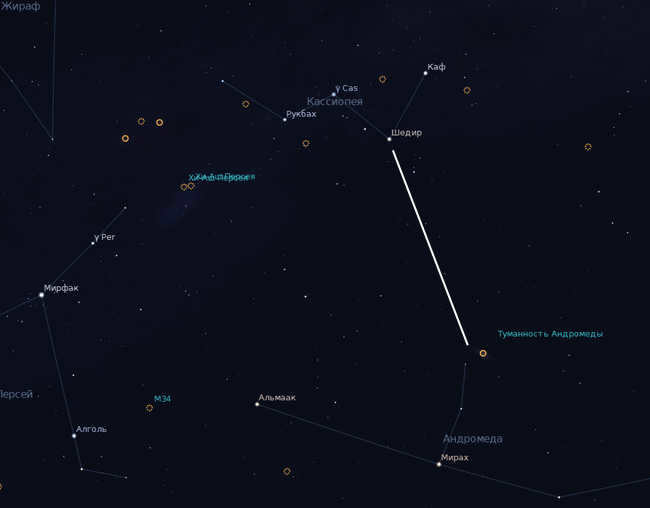
Utilize the appropriate, more acute section of the letter W as a cosmic pointer directing towards the Andromeda Nebula. Illustration: Stellarium
The gap from the tip of the pointer to the nebula is approximately fourfold the gap between the adjacent stars that constitute the letter W of Cassiopeia.
What to do if you can’t see the Andromeda Nebula?
If the Andromeda Nebula is not visible to the naked eye, you can try using binoculars or a telescope to find it.
Binoculars provide a wider field of view, making it easier to locate the galaxy. Begin your search from the star Mirach (Andromeda’s beta), then scan with your binoculars towards Andromeda’s mu and nu. In urban areas, the nebula will appear as a faint spot just above and to the right of nu Andromeda. Take your time to survey this part of the sky. Only in rural areas will the smooth, gentle glow of the galaxy become more noticeable.
When using the telescope, it is recommended to conduct the search starting from the star Mirach and moving through the mu and nu of Andromeda. It is advisable to use the lowest possible magnification in order to have a wider field of view. In general, high magnifications are not required for observing galaxies and faint nebulae as they can actually decrease contrast. If you own a Newtonian telescope, please note that it produces an inverted image. Alternatively, if you have a Go To telescope, you can simply enter the name of the nebula into the computer and the telescope will automatically point to it.
The Story of Mythology
In ancient Greek mythology, Andromeda was the daughter of King Cepheus of Ethiopia and his wife Cassiopeia. The legend surrounding the constellation has multiple variations. According to one version, Andromeda’s extraordinary beauty sparked jealousy among the sea nymphs known as the Nereids, who watched as she outshone them. To address this, Poseidon unleashed a fearsome monster upon Ethiopia, wreaking havoc on the villages and claiming lives. Seeking guidance, Cepheus consulted the Oracle, who advised that Andromeda be sacrificed to the creature in order to halt the devastation. Despite their sorrow, Andromeda’s parents dutifully chained her to a rock, awaiting the monster’s arrival. However, tragedy was averted when Perseus, passing by and instantly smitten with Andromeda, came to her rescue. Using the head of Medusa as a weapon, he vanquished the beast and married the beautiful maiden. As a result, Perseus and Andromeda now shine as constellations in the night sky. The gods also immortalized Cassiopeia, Cepheus, and even the sea monster in the vast expanse of space.
Position
The location of the Andromeda constellation is easily identifiable due to its distinctive shape, consisting of three sets of stars radiating from a central point. This cosmic pattern spans a wide expanse of the sky and is one of the largest constellations visible in both the northern and southern hemispheres. The brightest star within the Andromeda constellation, which serves as the starting point for the aforementioned sets of stars, is positioned along the border with the neighboring Pegasus constellation. Historically, this star was considered to be part of both celestial formations until the 17th century. It serves as the northern vertex of the Great Square within the Pegasus constellation.
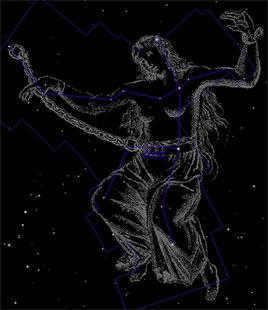
The Andromeda galaxy can be observed from various locations across Russia. During the summer and September months, it can be found in the eastern part of the sky, while in late fall and early winter, it can be seen in the southern part.
Alpha
The brightest star in the Andromeda constellation is Alpheratz (Alpha Andromeda). Its inclusion in the constellation was officially recognized in 1928. Prior to that, Alpheratz was considered part of the Pegasus constellation according to Ptolemy. The name itself has an interesting history, as it translates to “the navel of the horse” in Arabic.
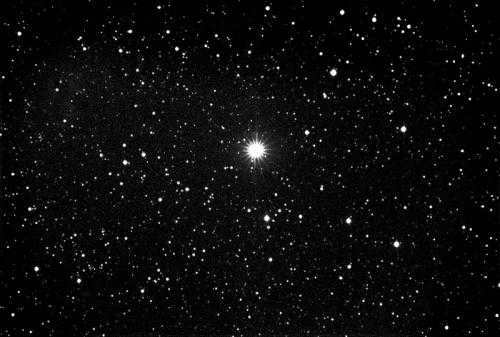
Alpheratz, a blue-white subgiant, emits 200 times more light than the Sun. It is also the primary component of a binary system. Its companion is 10 times less luminous.
Alpheratz A is one of the most luminous examples of a unique class of mercury-manganese stars. The high concentration of metals in its atmosphere, which gives the type its name, is caused by the varying effects of the star’s gravity and internal pressure on different chemical elements.
Alpheratz is also classified as a variable star, with a brightness range of +2.02 m to +2.06 m. These changes occur with a period of 23.19 hours.
Galaxy
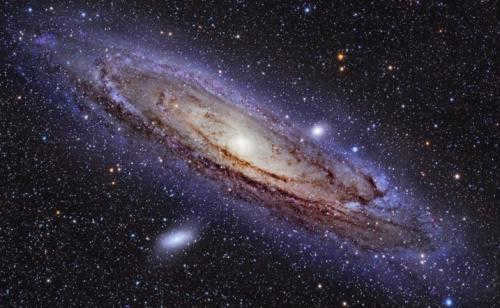
Many people are familiar with the constellation Andromeda not only for its impressive size or the beauty of its stars, but also for the presence of the M31 galaxy within its boundaries. This well-known neighbor of the Milky Way is one of the rare objects that can be observed with the naked eye. The Andromeda Nebula is situated just above the beta Andromeda star, known as Mirach. To observe the structure of the galaxy, binoculars are required at the very least.
The Andromeda Nebula is more than twice the size of our own galaxy and contains approximately 1 trillion stars. Additionally, it has two nearby satellites: the M32 and NGC 205 galaxies. The distance from the Sun to all three objects exceeds 2 million light years.
Supernova
The constellation Andromeda was the center of attention for numerous astronomers back in 1885. At that time, it experienced a sudden burst of light, making it the first known event of its kind outside of the Milky Way. The supernova S Andromeda can be found within the galaxy that shares its name, and it remains the only celestial body of its kind within that galaxy. On August 21-22, 1885, this celestial body reached its peak brightness, measuring at 5.85 magnitudes. Over the course of the next six months, its luminosity gradually decreased to a value of 14 magnitudes.
Presently, S Andromeda is categorized as a Type Ia supernova, although its orange hue and light curve deviate from the conventional description associated with such phenomena.
As a result of this, numerous urban residents lack the knowledge of where to direct their gaze in order to catch a glimpse of the renowned galaxy. In the meantime, the Andromeda Nebula (also known as the M31 galaxy, listed as object No. 31 in the Messier catalog) remains visible even in heavily populated areas, particularly when using binoculars or telescopes on nights with clear skies. The present moment, as well as the upcoming days when the Moon’s presence does not impede evening observations, provide an opportune time to attempt locating it within the celestial expanse.
In our previous article, we discussed the method of finding the galaxy using the constellations Pegasus and Andromeda. This is a traditional approach that works well for those who want to locate the galaxy with the naked eye or with the help of binoculars or a telescope. (If you’re using a telescope, make sure to start from the star Mirach in the constellation Andromeda.) If this method feels too challenging or if you’re having trouble spotting the galaxy in the sky, there is another way you can try. Begin your search by focusing on the constellation Cassiopeia.
During the late evening in November, Cassiopeia reaches its highest point in the sky. Its shape closely resembles the letter M or the Latin letter W. Image: Stellarium
Cassiopeia – Cassiopeia is a small group of stars that can be observed throughout the year in Russia. It is easily identifiable and memorable due to its formation, which resembles the letter W or an inverted M. During autumn, Cassiopeia becomes visible in the northeastern sky at dusk and continues to rise higher as the night progresses, reaching almost the zenith. Have you spotted the constellation? Take note that the right side of the celestial letter W appears sharper than the left side. This sharper half of the constellation serves as an arrow, directing towards the Andromeda Galaxy.
Utilize the right, sharper half of the letter W as the celestial arrow guiding towards the Andromeda Nebula. Image: Stellarium
The distance between the arrowhead and the nebula is approximately four times greater than the distance separating the neighboring stars that form the letter W of Cassiopeia.
Prior to heading out, practice observing this image without any connecting lines or constellation names. The Andromeda Nebula is depicted as an elongated, hazy spot within it. Figure: Stellarium
Keep in mind that even on a pitch-black night, the Andromeda Galaxy appears as a mere speck of light to the naked eye. This is not surprising considering that although M31 is home to nearly a trillion stars, its distance from us is immense at nearly 2.5 million light-years. Through binoculars, M31 appears as an elongated, milky-colored blur roughly the size of the Moon. Only with a high-quality telescope can you discern some structural details and a couple of satellite galaxies.
Some readers inquire why the Andromeda Galaxy is referred to as a nebula. That is how it has been known historically. When early astronomers first developed telescopes, they began to discover peculiar hazy patches scattered throughout the sky that resembled fragments of the Milky Way. These patches are known as nebulae, but astronomers had a rather limited understanding of their true essence. Over time, it was revealed that certain nebulae were actually distant clusters of stars (such as the globular M13 and the scattered Pleiades), some were even more remote galaxies, and some were in fact clouds of interstellar gas. However, from a historical perspective, the brightest galaxies and gas clouds are still referred to as nebulae, despite their considerably distinct nature.
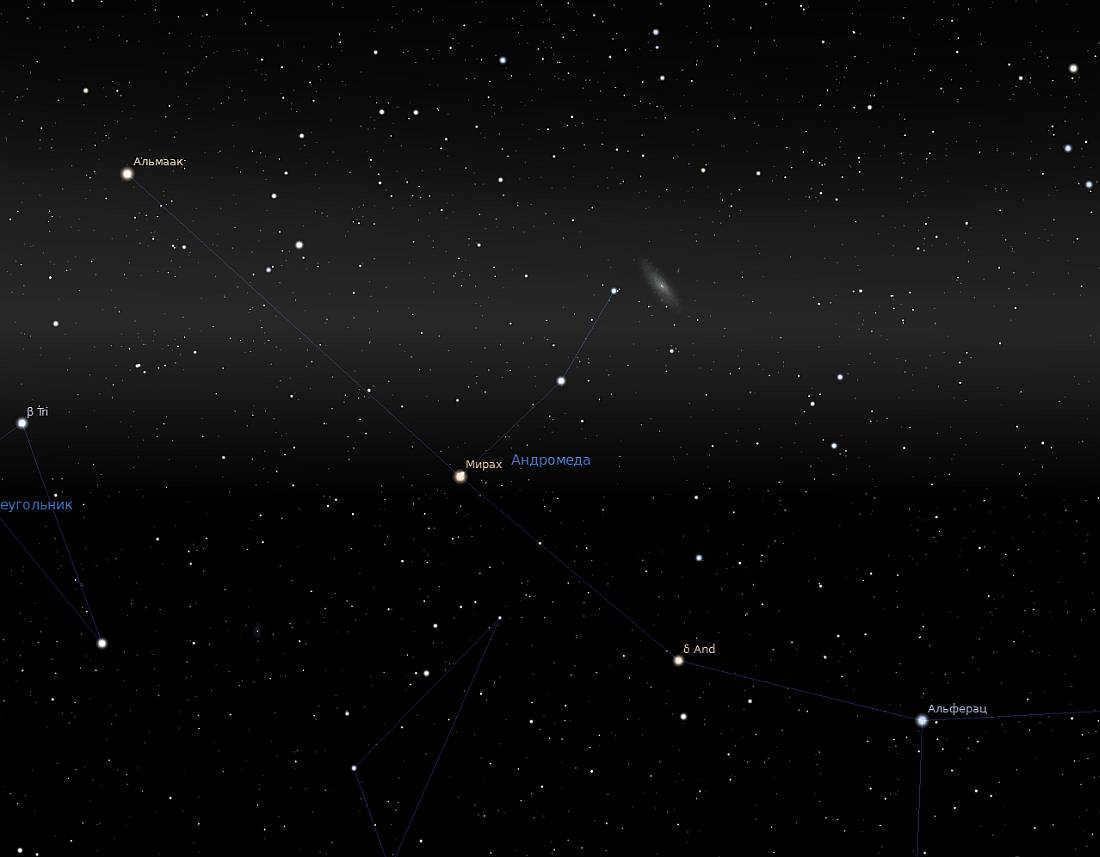
The Andromeda constellation is highly visible across Russia, offering excellent viewing opportunities throughout the night due to its high position in the sky. The best time to observe this constellation is in October and November, although September also provides a good starting point.
Locating the Andromeda constellation is relatively easy. Begin by locating the Great Square of Pegasus. In the northeastern corner of this square, you will find a star known as Alferats, which marks the starting point of Andromeda. This constellation covers an approximate area of 722 square degrees in the sky.
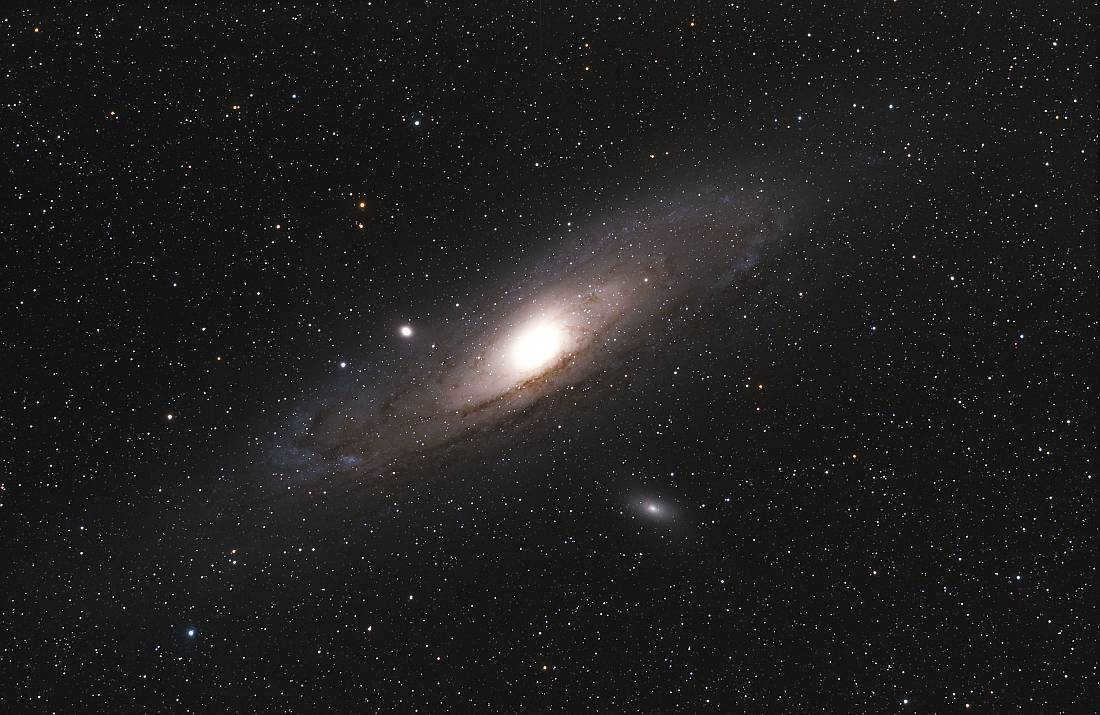
During a moonless and cloudless night, it is possible to observe approximately 160 stars with the naked eye in the constellation. These stars possess a luminosity of up to 6.5 star magnitudes.
An overview of the Andromeda Nebula galaxy, also known as M31.
Out of all the objects present in the constellation, the most remarkable one that can be seen is the spiral galaxy, also known as M31.
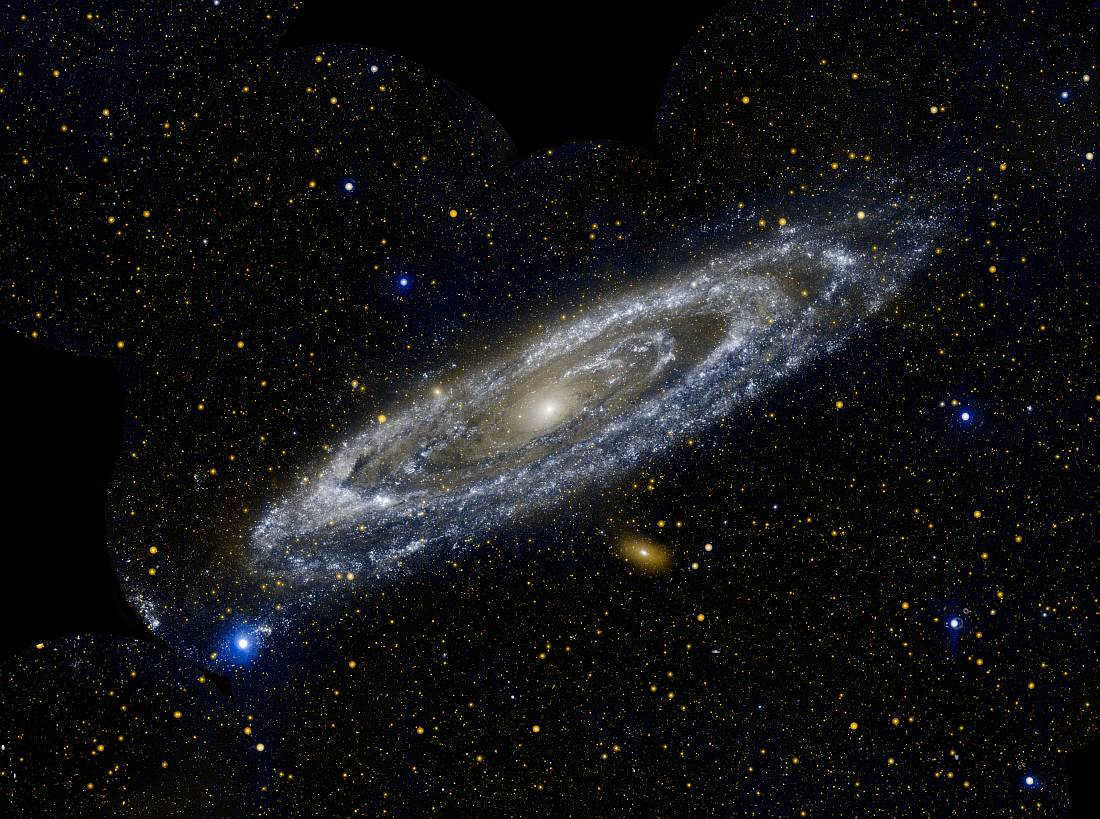
The Andromeda Galaxy, also known as M31, can be observed in the ultraviolet (UV) range.
Astronomers first observed the galaxy M31 in the 10th century, but its true nature was not fully understood until the 19th century, when powerful telescopes became available. Andromeda is home to a multitude of variables, star clusters, planetary nebulae, dwarf galaxies, and other fascinating objects.
Here is what M31 looks like when observed through a telescope.
Stellar Objects
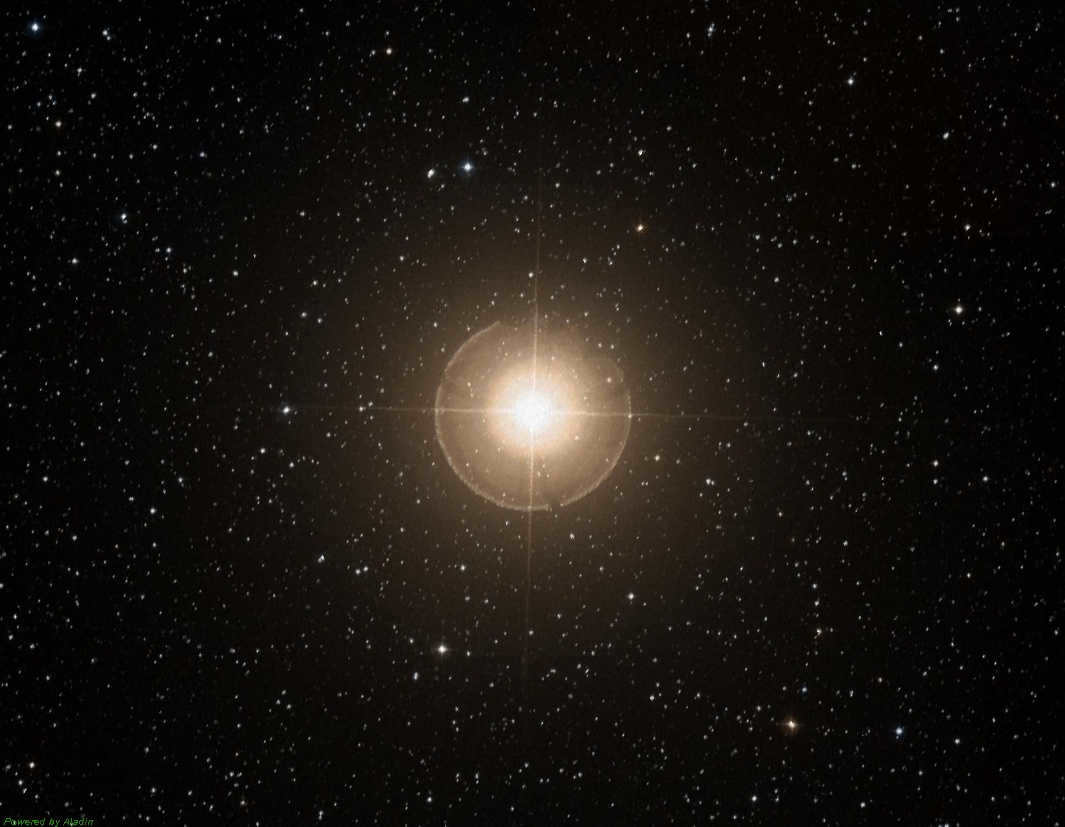
Almack is a system composed of three entities. The primary entity is a bright yellow star, possessing a second magnitude brilliance. It is accompanied by two physically linked blue stars.
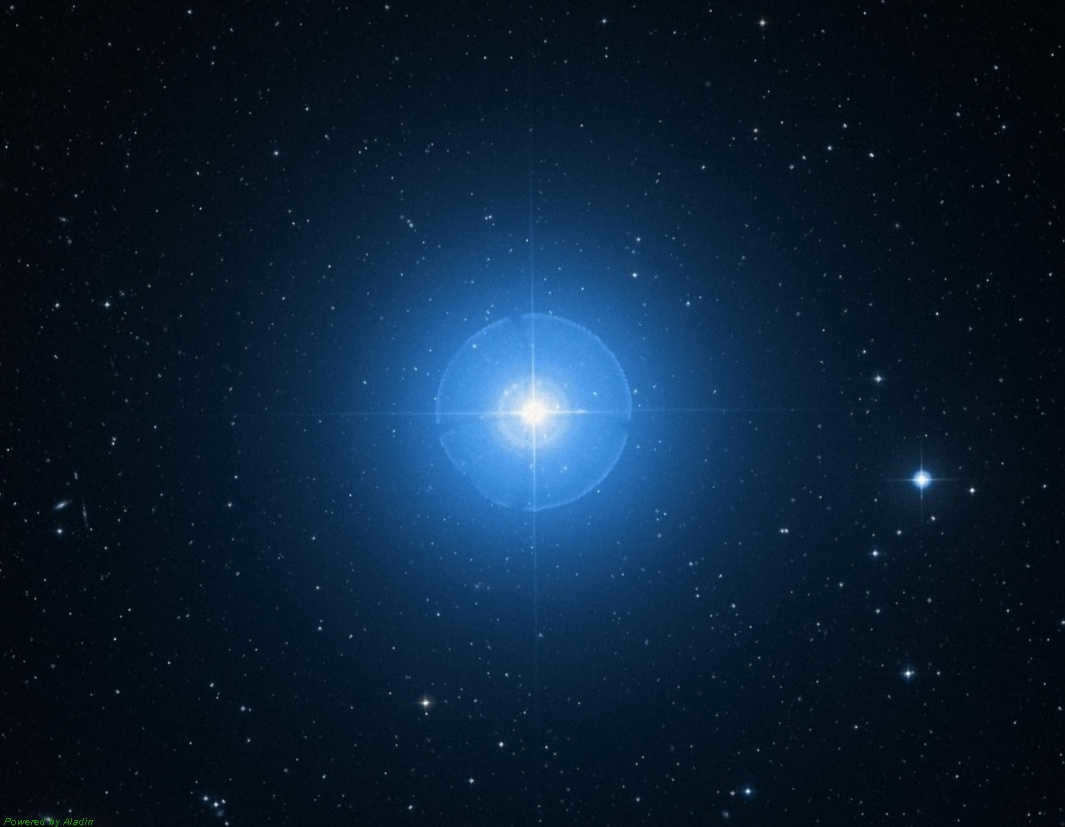
Alferac is a star with a brightness of 2.1 magnitude. It belongs to the category of navigational stars, similar to Almak. Ancient sailors used these stars as a guide to find their way back home.
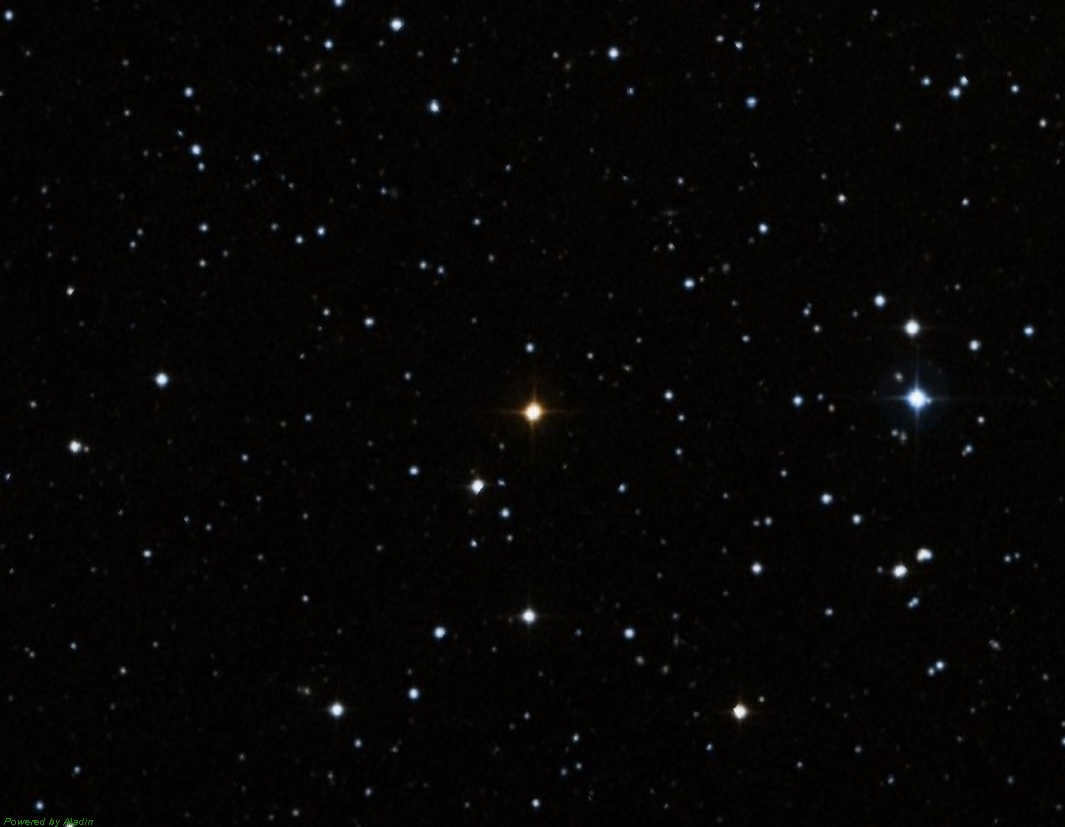

R Andromeda is a type of star that exhibits variability in its brightness. The magnitude of this variation is nine stellar magnitudes.
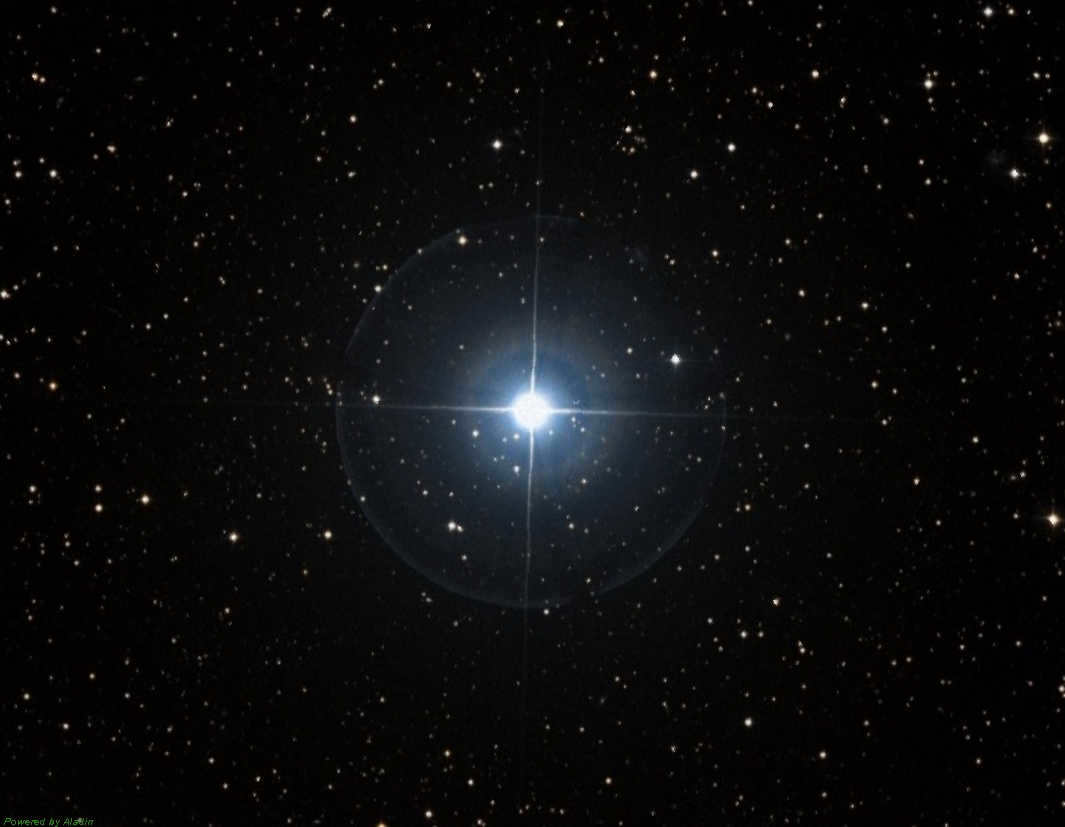
υ Andromeda is a star located on the main sequence that has been found to possess a planetary system. Among the planets in this system, planet b resembles Jupiter in its characteristics, while the other two planets are known for their eccentric and giant nature.
Galaxies
The Andromeda Nebula holds a significant place in the world of astronomy as one of the most renowned galaxies. Its existence was initially observed by a Persian astronomer during the 10th century. Additionally, the Andromeda Nebula is accompanied by two smaller galaxies, namely M32 and NGC 205, which are considered its satellites.
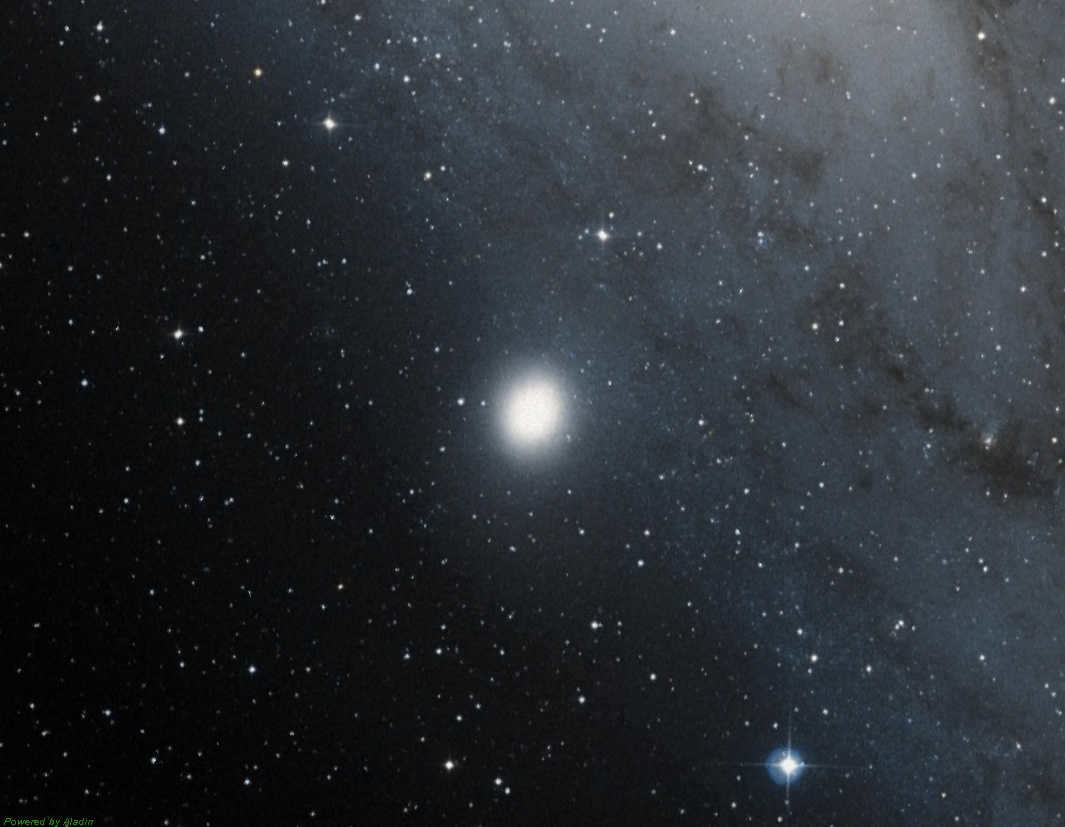
The Andromeda Galaxy has a satellite known as the dwarf elliptical galaxy M32.
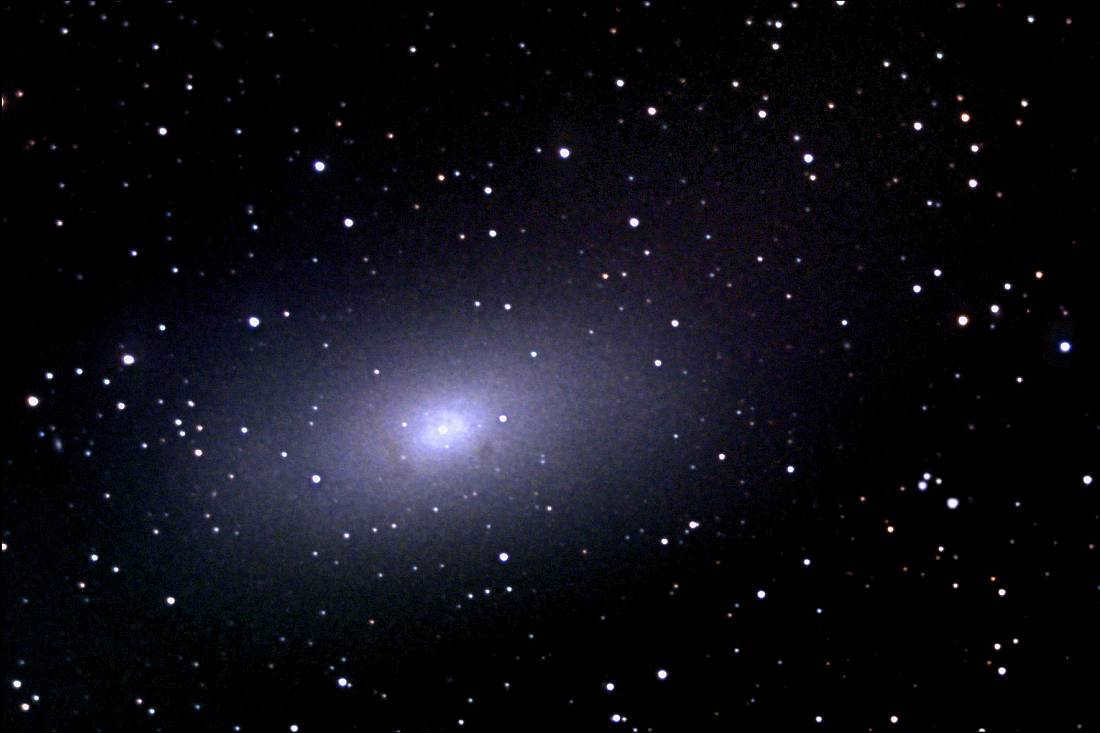
The Andromeda galaxy can be easily observed in the night sky without the aid of a telescope. It spans a diameter of approximately 220,000 light-years and is home to over 300 billion stars. Situated at a distance of 2.2 million light-years from our own Milky Way galaxy, this nearest spiral galaxy is a remarkable sight. Within the vast expanse of the Andromeda galaxy, numerous globular clusters can be found. The systematic study of galaxies began with the observation of M32, and the Hubble telescope played a crucial role in these groundbreaking observations.
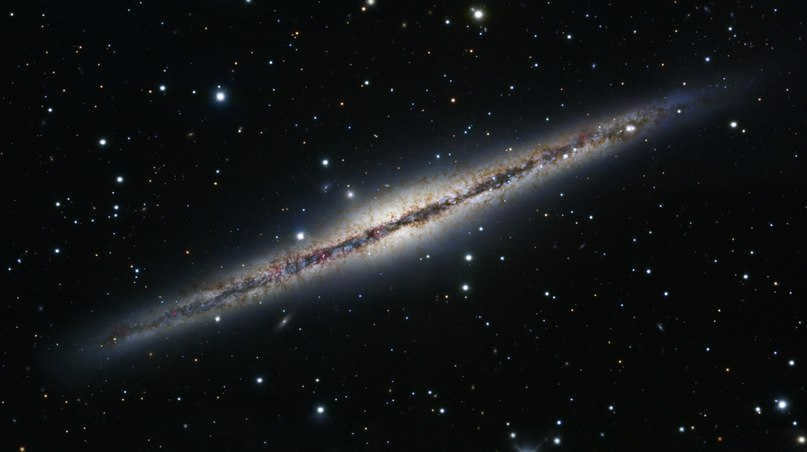
NGC 891 is an extraordinarily captivating galaxy. Situated before us, it presents a ribbed appearance that is truly stunning.
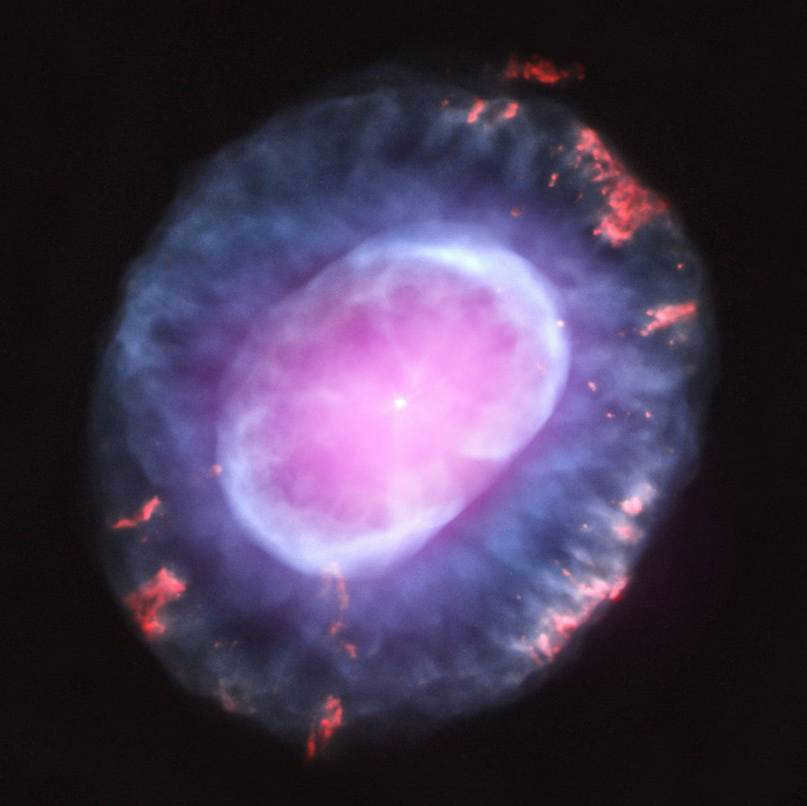
Aside from the galaxies, there also exists a planetary nebula known as NGC 7662 and a star hosting the exoplanet WASP-1.
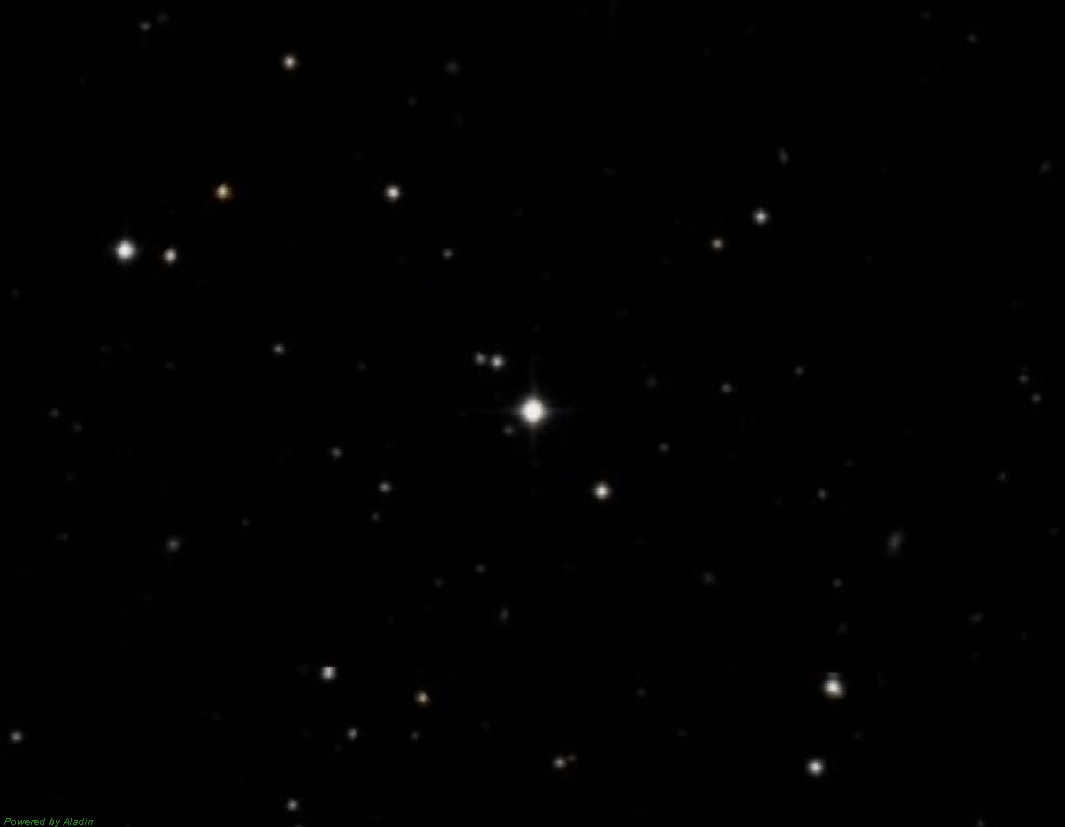
The Milky Way and M31 merger
Currently, our local cluster consists of two major galaxies – the Milky Way and M31. Over the course of several billion years, these galaxies are on a collision course and will eventually merge into a single massive galaxy. This cosmic event will be a remarkable display of cosmic proportions. Scientists have even created simulations to envision the appearance of this merger.
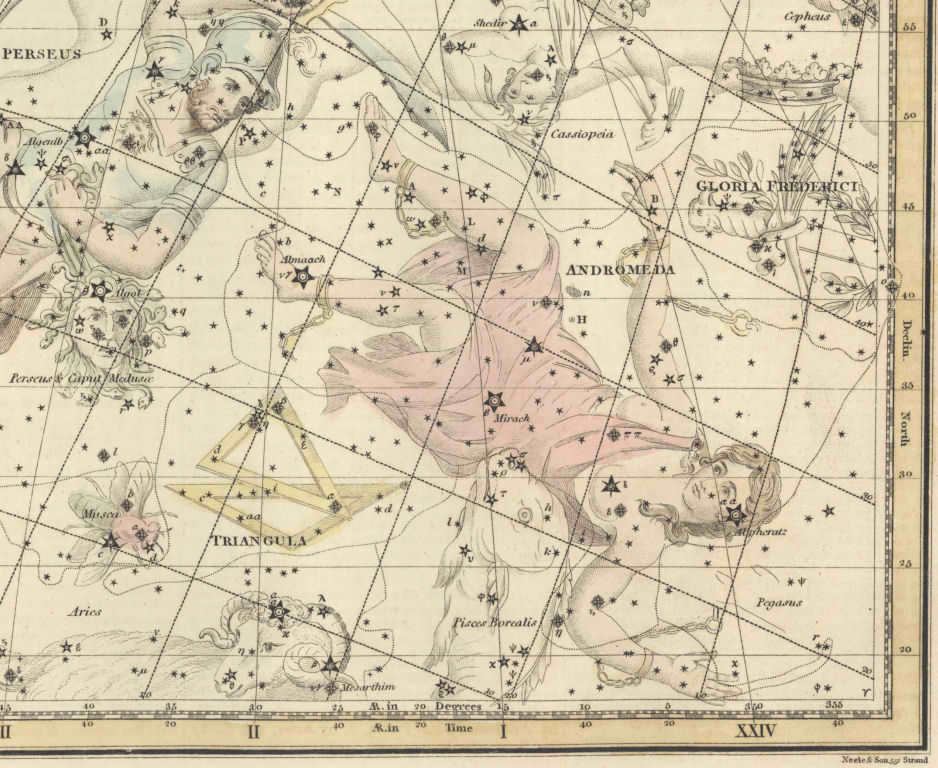
The Almagest includes the oldest constellation. According to Greek mythology, Princess Andromeda was given to a sea monster by King Cepheus. However, she was rescued by Perseus and after her death, the gods placed her among the stars.
This constellation can be easily seen with the naked eye and is the only spiral galaxy, apart from our own, that is visible in suburban skies. The best time to observe the Andromeda Nebula is during dark, moonless fall evenings. During this time, the galaxy is positioned high in the sky, where the transparency is better than at the horizon and the city lights are less distracting.
Among all celestial objects, the Andromeda Nebula is one of the brightest and largest in the fall sky. So, how can you locate this galaxy during the fall season?
There are two traditional methods.
Method No. 1: utilizing the Square of Pegasus
In the summer sky, the primary star pattern is replaced by another asterism known as the Great Square of Pegasus during the fall season. (They are often referred to without the “big” prefix.) The Great Square of Pegasus can be found in the southeast after sunset, to the left of the Summer Triangle. By midnight, it will be located on the southern side of the sky. Locate this quadrangle by noting that the stars that form it have a similar brightness to those of the Big Dipper, which is visible to the north during this time.
Figure: Stellarium
Next to the square on the left, there is a sequence of three stars that are approximately the same brightness. The sequence curves upwards, giving the appearance of a large coffee pot in the Pegasus constellation. These stars are part of the Andromeda constellation.
Now, focus on the middle star in the sequence, or more specifically, the area around it. Above it, you will notice two dimmer stars. This is actually a good test. If you can confidently see these stars, there is a good chance you will be able to see the Andromeda Nebula.
If you struggle to see the two stars, it means the sky quality is not ideal, and you may need binoculars or a telescope to locate the Andromeda Galaxy. That’s perfectly fine, as not everyone has access to these tools!
Okay, we’re almost done. The Andromeda Nebula is situated just above and to the right of another star known as the Andromeda Nebula. the Andromeda Nebula..
In the Pegasus square, you can find the constellation Andromeda and the Andromeda Nebula (highlighted). Figure: Stellarium
Method #2: Starting from the constellation Cassiopeia.
The constellation Cassiopeia is easily recognizable due to its distinct pattern – resembling the letter M or the Latin letter W. This compact constellation remains visible in our sky throughout the year. During the autumn season, Cassiopeia can be observed in the eastern part of the sky during the evenings, approximately 60° above the horizon. At midnight, it reaches its highest point in the sky (zenith).
The Andromeda Nebula is located by beginning from the stars of Cassiopeia. Picture: Stellarium
Both search choices are equally simple. Maybe the initial approach is a bit more dependable, as it provides the precise position of the nebula right next to the star. However, you can effortlessly blend the two approaches – for example, locate the Andromeda constellation from the Cassiopeia constellation and identify the Andromeda Nebula using two stars.
Let’s talk about the appearance of a galaxy when observed without the aid of a telescope. In a sky devoid of light pollution, a galaxy will appear as a dim elongated shape, roughly half the size of the visible disk of the Moon. However, no specific details will be discernible to the naked eye. If the sky conditions are not ideal, the galaxy may not be visible to direct vision, or it may be extremely faint. In such cases, it may be helpful to use peripheral vision. This involves looking slightly away from the location of the Andromeda Nebula, while simultaneously attempting to perceive its faint luminosity.
It goes without saying that spotting the Andromeda Nebula in an urban environment is exceedingly challenging. The ability to do so largely hinges on the atmospheric conditions and the selection of a suitable location. It is advisable to seek out a site that is shielded from the glare of street lights to maximize visibility. It is crucial to avoid observing under the illumination of the Moon. Before embarking on your observation, allow your eyes to adjust to the darkness for approximately 10 minutes. During this period, it is important to remain in complete darkness. The rest of your success will rely on your patience, experience, and the prevailing atmospheric conditions.
Astronomy is an incredibly captivating field of study that unveils the vastness and variety of the Universe to curious individuals. It is rare to find someone who, as a child, did not gaze up at the night sky and marvel at the twinkling stars. This spectacle is particularly awe-inspiring during the summer months when the stars appear to be within reach, shining with extraordinary brightness. In recent times, astronomers from all corners of the globe have developed a particular fascination with Andromeda, the galaxy that is nearest to our own Milky Way. We set out to explore the reasons behind this scientific intrigue and whether Andromeda can be observed with the naked eye.
The galaxy known as the Andromeda Nebula, or simply Andromeda, is among the largest galaxies in existence. In fact, it is even larger than our own Milky Way, which is home to our solar system, by about three to four times. Preliminary estimates suggest that Andromeda houses approximately one trillion stars.
Andromeda is classified as a spiral galaxy and can actually be observed in the night sky without the need for special optical equipment. However, it is important to note that the light emitted by this star cluster takes over two and a half million years to reach our planet Earth! Astronomers speculate that we are currently observing the Andromeda Nebula as it appeared two million years ago. Truly a remarkable phenomenon, wouldn’t you agree?
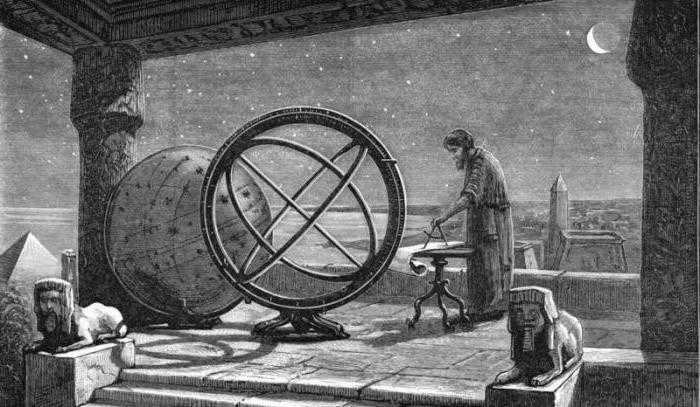
A Historical Account of Observations on the Andromeda Nebula
The Andromeda Nebula was initially spotted by an astronomer hailing from Persia. This astronomer documented his findings in the year nine hundred and forty-six, describing it as a hazy glow. It took another seven centuries before a German astronomer meticulously observed the galaxy using a telescope.
It was in the mid-nineteenth century that astronomers made the significant discovery that the spectrum of Andromeda differed greatly from any previously known galaxies. Based on this observation, they postulated that it was comprised of numerous stars. This hypothesis was eventually proven to be accurate.
It wasn’t until the late nineteenth century that a photograph of the Andromeda Galaxy was finally captured, revealing its distinct spiral structure. Prior to this, it was commonly believed to be a mere extension of the Milky Way.
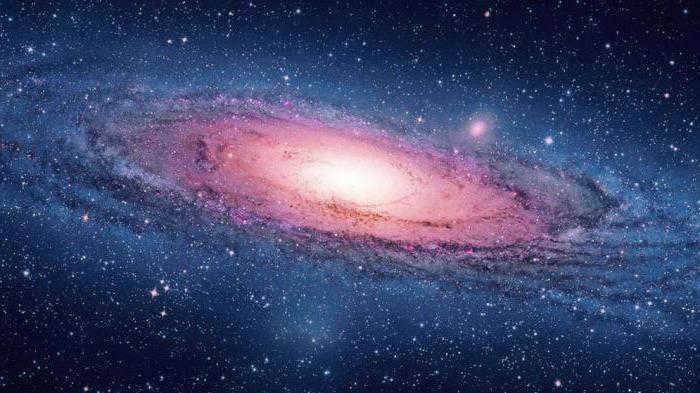
Galaxy Composition
Using advanced telescopes, astronomers have been able to examine the composition of the Andromeda Nebula. The Hubble telescope has revealed the presence of approximately four hundred young stars orbiting the black hole. These star clusters are estimated to be around two hundred million years old. This arrangement of stars within the galaxy has astounded scientists, as it was previously unimaginable that stars could form around a black hole. According to current scientific understanding, the condensation of gas to form stars is considered impossible under the conditions of a black hole.
There are multiple satellite dwarf galaxies surrounding the Andromeda Nebula, potentially indicating absorption as their origin. This is particularly intriguing considering the anticipated collision between the Milky Way and the Andromeda Galaxy, although this remarkable event is expected to occur in the near future.
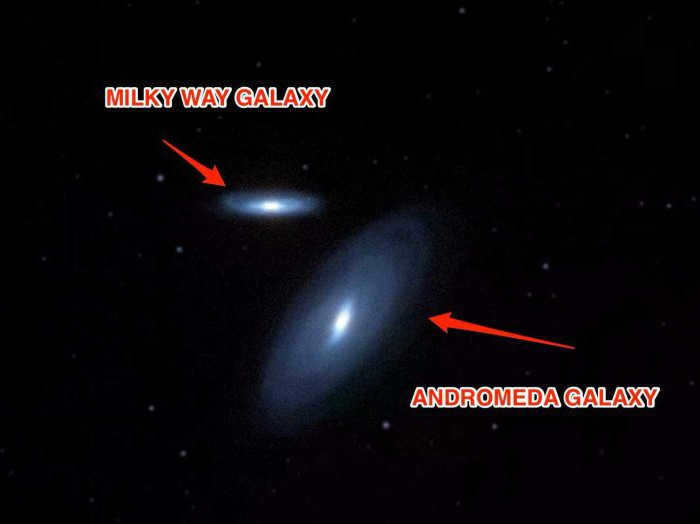
Andromeda Galaxy and the Milky Way: approaching each other
For a long time, scientists have been making predictions based on their observations of the movements of both star systems. It has been observed that Andromeda, a galaxy, is constantly moving towards the Sun. In the early 20th century, an American astronomer managed to calculate the speed at which this movement occurs. This measurement, which is three hundred kilometers per second, is still widely used by astronomers around the world in their observations and calculations.
Collision: What Can We Expect?
Inevitably, the Milky Way will be absorbed by Andromeda, and astronomers are actively working to model and understand this process. By analyzing computer data, scientists have determined that the solar system will end up on the outskirts of the galaxy after the absorption, approximately one hundred and sixty thousand light years away. This is a significant distance compared to our current position, which is only twenty-six thousand light years away from the center of the galaxy.
The future galaxy, known as Milkycomeda, has already been christened and astronomers predict that the merger will revitalize it for at least one and a half billion years. As a result, the formation of new stars will occur, enhancing the brightness and beauty of our galaxy. Additionally, this process will lead to a transformation in shape. Currently, the Andromeda Nebula is positioned at an angle relative to the Milky Way. However, through the merger, the resulting system will take on an elliptical form and expand in size, so to speak.
The future of mankind: can we survive the cosmic encounter?
And what will be the fate of humanity? How will the convergence of galaxies impact our planet? Remarkably, scientists assure us that there will be absolutely no harm. All the transformations will manifest in the emergence of novel stars and constellations. The celestial map will undergo a complete overhaul, as we find ourselves in an entirely new and uncharted region of the galaxy.
Naturally, a small fraction of astronomers entertain the possibility of negative outcomes. In such a scenario, Earth could potentially collide with the Sun or another celestial object from the Andromeda Galaxy.
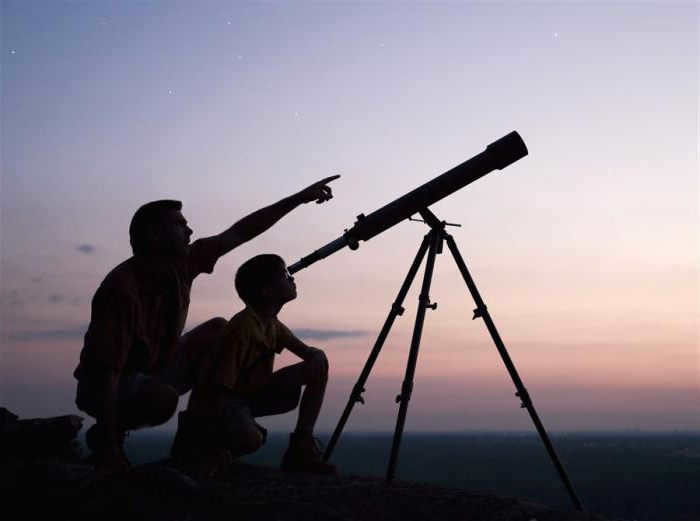
Do planets exist in the Andromeda Nebula?
Scientists consistently conduct searches for planets in various galaxies. Their efforts to find a planet in the Milky Way with similar characteristics to Earth are ongoing. Currently, over three hundred objects have been discovered and documented, but all of them are located within our own solar system. In recent years, astronomers have directed their attention towards Andromeda, questioning the existence of planets within it.
Thirteen years ago, a team of astronomers proposed a hypothesis using advanced techniques that one of the stars within the Andromeda Nebula possesses a planet. This planet is estimated to have a mass approximately six percent of Jupiter, the largest planet in our solar system. In comparison, its mass is three hundred times that of Earth.
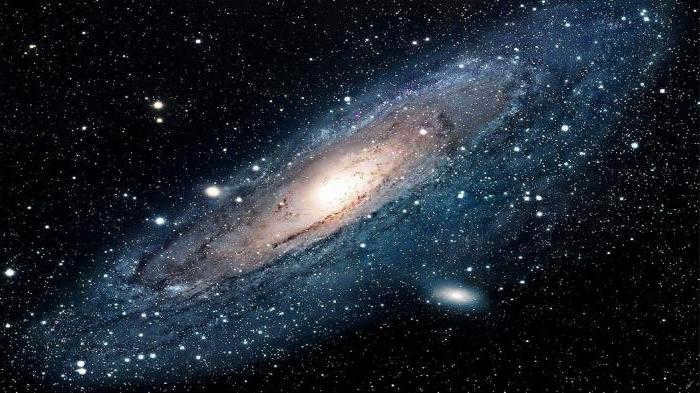
Preparing for a Celestial Quest: Seeking out a Galaxy in the Celestial Sphere
As mentioned previously, it is indeed possible to spot a neighboring galaxy in the night sky with the naked eye. However, this endeavor requires a basic understanding of astronomy, such as recognizing various constellations and being able to locate them.
Furthermore, attempting to view specific star clusters in an urban environment is challenging due to light pollution, which obstructs visibility for stargazers. Thus, if you yearn to witness the grandeur of the Andromeda Nebula firsthand, venture out to the countryside during the late summer or seek solace in a city park with minimal street lighting. The optimal period for observation is October, although it remains fairly visible above the horizon from August through September.
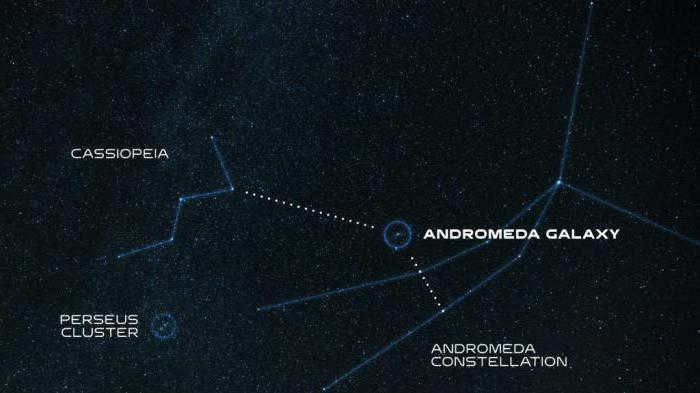
Diagram to Locate the Andromeda Nebula
Ambitious young astronomers often yearn to catch a glimpse of the actual appearance of Andromeda. The galaxy appears as a small, luminous dot in the sky, but can be identified by its proximity to the bright stars surrounding it.
In the autumn sky, locating Cassiopeia becomes a breeze – it resembles the letter W, albeit more elongated than its written representation. This constellation is typically highly visible in the Northern Hemisphere and can be found in the eastern part of the sky. The Andromeda Nebula galaxy lies just below it. Spotting it requires a few additional reference points.
Below Cassiopeia there are three bright stars, arranged in a line and displaying a reddish-orange hue. The middle star, known as Mirac, serves as a reliable reference point for novice astronomers. By drawing a vertical line upwards from Mirac, you will come across a faint luminous patch resembling a cloud. This luminosity actually emanates from the Andromeda Galaxy, a remarkable sight that predates the existence of humanity on Earth. Truly astonishing, isn’t it?
M31 Andromeda Nebula.
28/11/2010, Deepsky 80\560ED telescope, WO 0.8x II reducer-corrector, Canon 1000D, ISO 1600, shutter speed 1 minute, 10-15 frames. Mount – EQ5
If you want to locate the famous Andromeda Nebula (M31), the ideal time to observe it is during the autumn season. However, you can also attempt to find it during other times of the year, such as in the morning during the summer. To locate it, first, position yourself towards the northern part of the sky. Then, locate the Big Dipper constellation and trace a line from the handle of the “bucket” through Polaris. By continuing this imaginary line, you will come across an inverted letter M or W, which represents the Cassiopeia constellation. Cassiopeia is a relatively bright constellation, making it easy to spot.
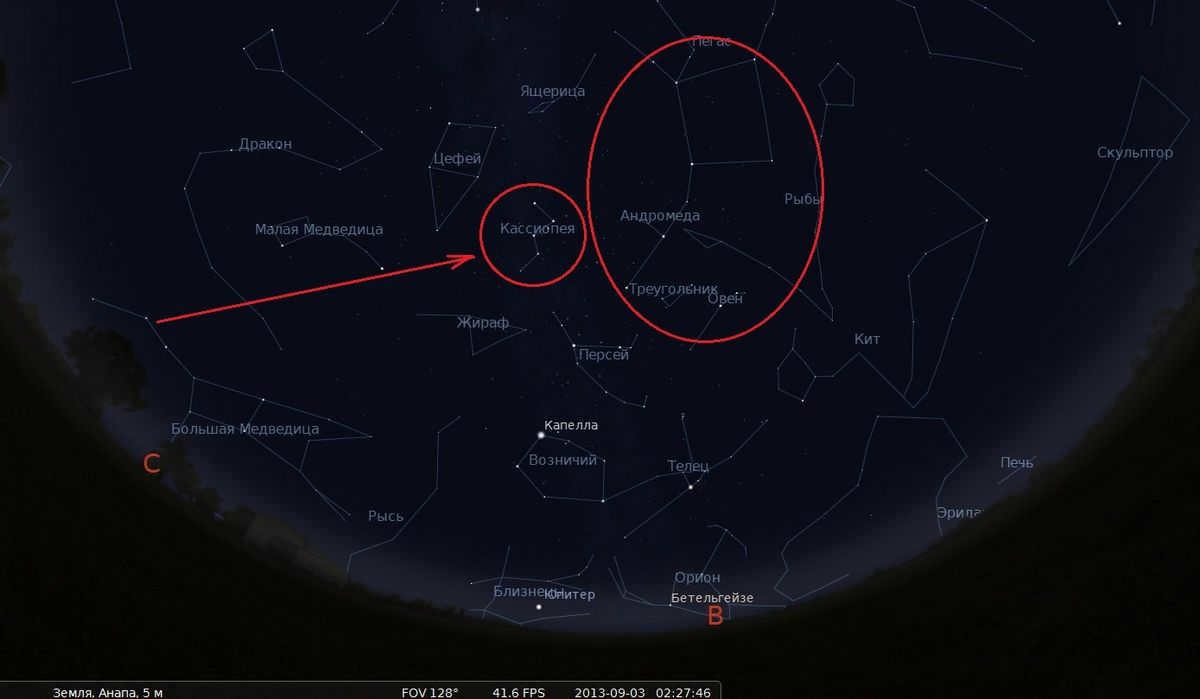

Next, we shift our gaze to the right, towards the southeastern region of the celestial sphere – and there, we can observe two prominent constellations, namely Andromeda and Pegasus. One notable attribute is the well-known “Square of Pegasus” – a configuration comprising of four stars, creating a distinct “square” shape.
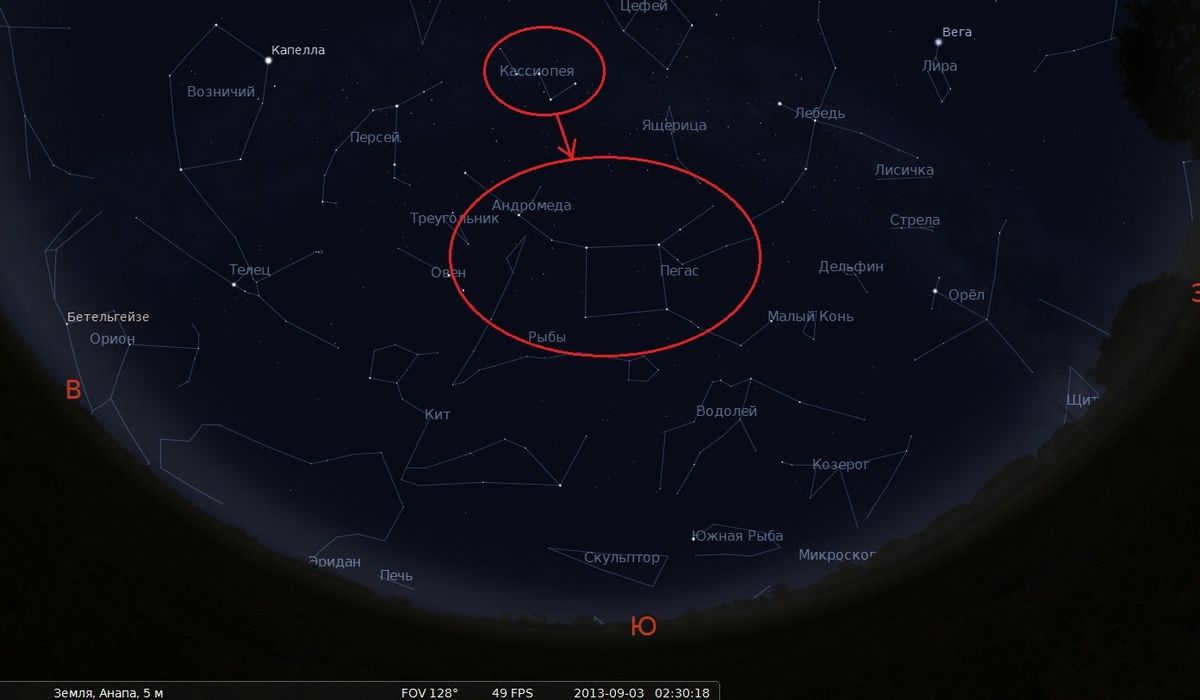
By following these instructions, you can locate the Andromeda Nebula in the night sky. Start by visualizing an imaginary line that extends from the stars to the left and then upwards. Once you have positioned yourself correctly and have a pair of binoculars, a telescope, or a reliable optical finder in hand, direct your gaze to the designated spot. If you have executed the steps accurately, you will be able to observe a small luminous oval cloud. Congratulations, what you are witnessing is the Andromeda Nebula – a vast galaxy that is currently approaching our own Milky Way. It is worth mentioning that this galactic collision is projected to occur in approximately 3-4 billion years.
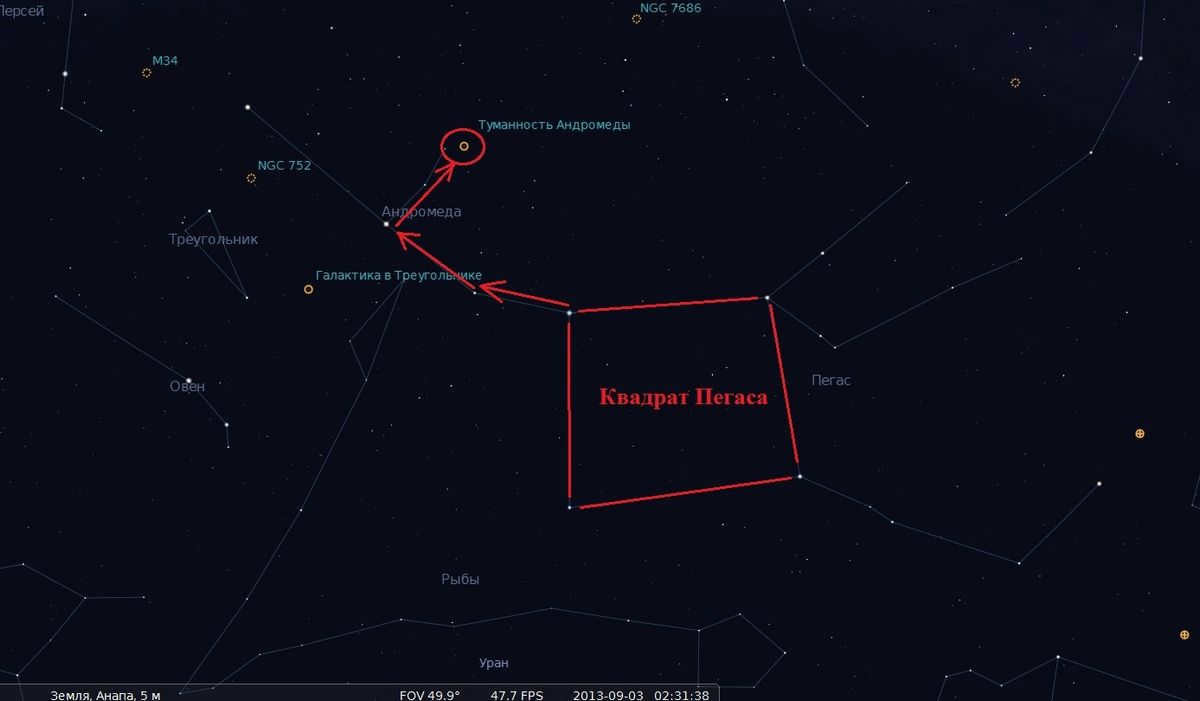
In small telescopes, the Andromeda Nebula can be seen similarly to binoculars, but in larger telescopes, it appears as a large oval spot. Additionally, its satellites, the small galaxies M32 and M110, can also be observed. When viewed through 20×60 binoculars, the Andromeda Nebula fills the entire field of view. Its visual size is approximately 3…3.5 degrees, which is 7 times the apparent size of the Moon! Telescopes with larger diameters, such as those with a diameter of 250mm or more, allow for the observation of dust tracks near the center of the galaxy. To have a successful observation, it is important to have a dark sky and minimal light pollution.
The Andromeda Nebula is much more visually stunning in images, especially because of the visibility of dust clouds along the center of the galaxy. Even with a simple motorized equatorial mount and a DSLR camera with a standard lens, it is possible to obtain beautiful images of the galaxy.
Andromeda, also known as M31 and NGC224, is a spiral galaxy situated approximately 780 kp (2.5 million) from Earth.
Andromeda is the nearest galaxy to the Milky Way and derives its name from the mythical princess Andromeda. In 2006, observations indicated that there are roughly a trillion stars in Andromeda, which is at least twice the number found in the Milky Way, where there are about 200-400 billion stars. Scientists predict that the Milky Way and Andromeda Galaxy will collide in approximately 3.75 billion years, resulting in the formation of a massive elliptical or disk galaxy. However, we will delve further into this topic later. First, let’s explore the appearance of the “mythical princess.”
The image depicts Andromeda, a galaxy characterized by its blue-white stripes. These stripes encircle the galaxy, housing hot, luminous giant stars. In contrast, darker blue-gray bands stand out against the bright rings, indicating areas where star formation is just commencing within dense cloud cocoons. When observed in the visible spectrum, Andromeda’s rings resemble spiral arms, but in ultraviolet, they take on a more ring-like structure. These ring formations were previously detected by a NASA telescope and are believed to signify the galaxy’s formation following a collision with a neighboring galaxy over 200 million years ago.
Andromeda’s Moons
Similar to our own galaxy, the Milky Way, Andromeda possesses several small moons, with 14 having been identified thus far. The most well-known of these are M32 and M110. It is highly unlikely that the stars from each galaxy will collide, as the distances between them are immense. Scientists currently have limited knowledge regarding what will actually occur. However, they have already devised a name for the forthcoming creation. Mlecomeda is the proposed title for the as-yet-unborn colossal galaxy, as determined by the esteemed minds of the scientific community.
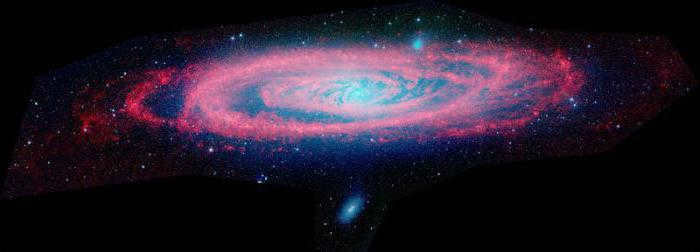
Stars merging
Andromeda contains a whopping 1 trillion stars (10 12), while the Milky Way boasts 1 billion (3*10 11). However, the likelihood of these celestial bodies colliding is incredibly low due to the vast distance separating them. To put it into perspective, the nearest star to the Sun, Proxima Centauri, is situated 4.2 light years away (4*10 13 km) – equivalent to 30 million (3*10 7) solar diameters. If we were to imagine our Sun as a table tennis ball, Proxima Centauri would resemble a small pea positioned 1100 km away. Furthermore, the Milky Way itself stretches an impressive 30 million km in width. Even the stars located at the galactic center, where they are densely clustered, are spaced approximately 160 billion (1.6*10 11) km apart. This is akin to having one table tennis ball for every 3.2 km. Consequently, the odds of two stars colliding during a galaxy merger are extremely minuscule.
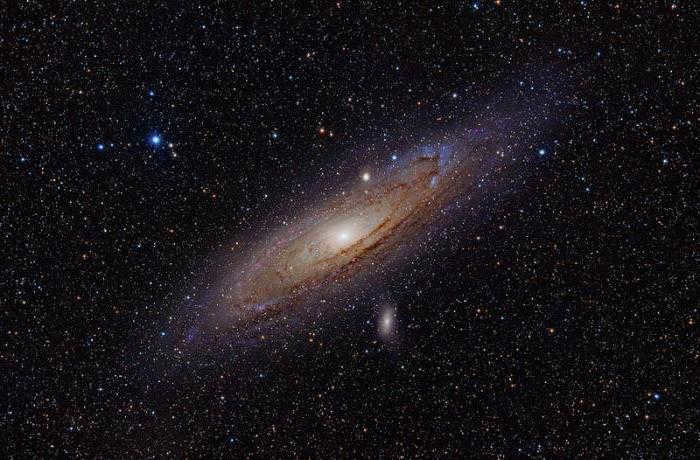
Collision of Black Holes
In the vast expanse of the universe, the Andromeda Galaxy and the Milky Way have their own central Sagittarius A, which has a mass equivalent to 3.6*10^6 solar masses. Additionally, there is an object located inside the P2 cluster of the Galactic nucleus. These two massive black holes will eventually come together at a single point near the center of the newly formed galaxy. This cosmic dance will transfer orbital energy to the surrounding stars, causing them to gradually move to higher trajectories in their cosmic journey. It is a slow process that could take millions of years to complete. However, as the black holes approach within a light-year of each other, they will emit gravitational waves, further amplifying their orbital energy until the merger is complete.
Based on simulations conducted in 2006, it is speculated that during this galactic collision, Earth may experience an extraordinary ride. Initially, our planet may be flung towards the very center of the newly formed galaxy, defying the laws of gravity as we know them. Then, as we traverse the galactic landscape, we may come dangerously close to one of the merging black holes, only to be ultimately ejected beyond the boundaries of our familiar Milky Way, finding ourselves in the realm of Mlecomeda, a cosmic encounter beyond our wildest imagination.
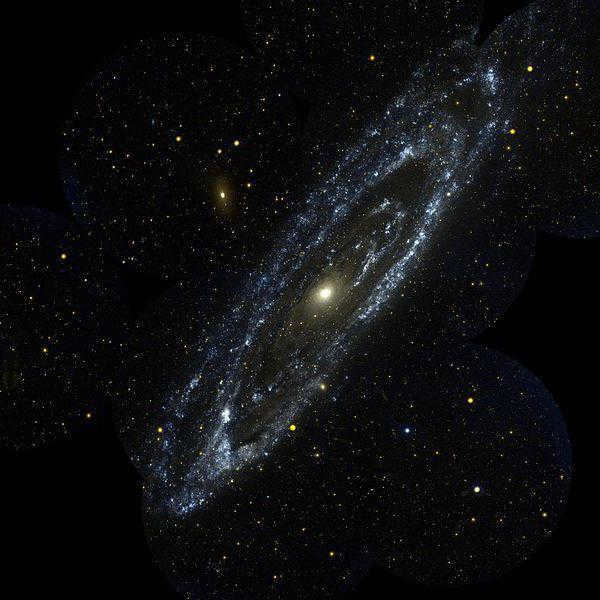
Evidence supporting the hypothesis
The hypothesis that the Andromeda Galaxy is moving towards our galaxy at a velocity of around 110 kilometers per second has been confirmed. Prior to 2012, there was no definitive way to determine whether a collision would take place. However, with the assistance of the Hubble Space Telescope, scientists were able to observe Andromeda’s movements from 2002 to 2010 and deduce that a collision is highly likely to occur in approximately 4 billion years.
These types of occurrences are not uncommon in the vastness of space. For instance, it is believed that Andromeda has previously interacted with at least one other galaxy. Additionally, certain dwarf galaxies, like SagDEG, are still colliding with our own Milky Way, resulting in the formation of a combined structure.
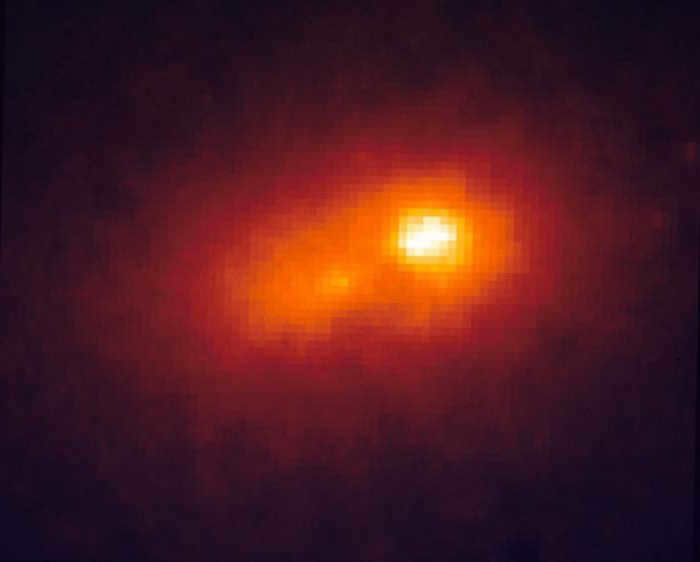
Research has also indicated that M33, also known as the Triangle Galaxy, which is the third largest and brightest member of the Local Group, will also play a role in this event. It is expected to eventually enter the orbit of the celestial body that forms after the merger, and in the distant future, will merge completely. However, the possibility of M33 colliding with the Milky Way before the approach of Andromeda, or our Solar System being expelled from the Local Group, has been ruled out.
Fate of the Solar System
According to researchers from Harvard University, the merger of galaxies and its timing will be influenced by the tangential velocity of the Andromeda galaxy. After conducting calculations, they have determined that there is a 50% probability that during the merger, the Solar System will be propelled away to a distance three times greater than its current distance from the center of the Milky Way. The behavior of the Andromeda galaxy remains uncertain, which puts planet Earth at risk. The scientists state that there is a 12% chance of being flung back beyond our previous “home” after the collision. However, it is unlikely that this event will cause significant harm to the Solar System, and the celestial bodies within it will not be destroyed.
If we do not consider planetary engineering, it is predicted that by the time the Earth’s surface becomes extremely hot, there will be no liquid water left, resulting in the absence of life on the planet.
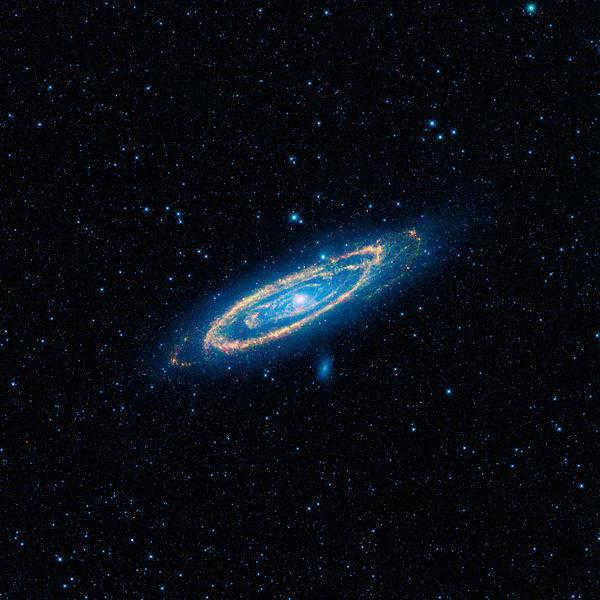
Possible adverse effects
When two spiral galaxies combine, the compression of hydrogen in their disks occurs. This leads to an increase in the formation of new stars. A good example of this phenomenon can be observed in the interacting galaxy NGC 4039, also known as “Antennas”. In the event of a merger between Andromeda and the Milky Way, it is expected that there will be minimal gas remaining in their disks. As a result, star formation would not be as intense, although the possibility of quasar nucleation cannot be ruled out.
The outcome of the merger
Scientists have given the temporary name Mlecomeda to the galaxy formed as a result of the merger. According to the modeling results, the resulting entity is expected to have an elliptical shape. The center of this object will have a lower star density compared to present-day elliptical galaxies. However, there is also a possibility of it having a disk shape. The ultimate outcome will depend on the amount of gas that remains within both the Milky Way and Andromeda. In the near future, these remnants will merge into a single entity, signaling the beginning of a new phase in cosmic evolution.
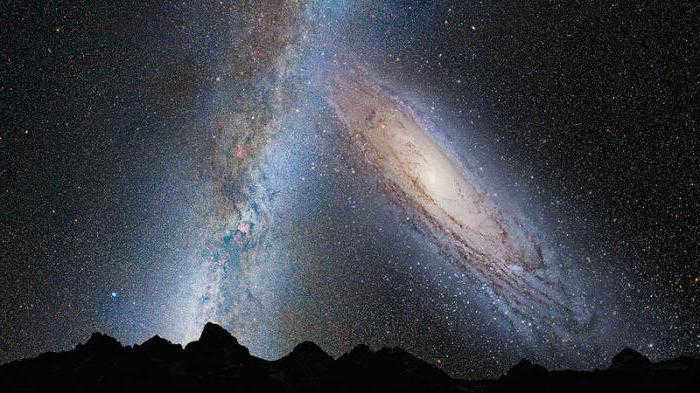
Interesting Information about Andromeda
- Andromeda, which can be found on the starry sky, is the largest galaxy within the Local Group. However, it might not be the most massive one. Scientists believe that the Milky Way is more concentrated, which contributes to its greater mass.
- Scientists are conducting research on Andromeda in order to gain a better understanding of the origin and development of similar celestial formations. This is due to the fact that Andromeda is the nearest spiral galaxy to our own.
- Andromeda is a breathtaking sight when observed from Earth. Many individuals have even managed to capture its beauty through photography.
- The galactic core of Andromeda is incredibly dense. Not only does it contain enormous stars, but it is also believed to house at least one supermassive black hole that remains hidden within.
- The spiral arms of Andromeda have been distorted as a result of gravitational interactions with two neighboring galaxies, M32 and M110.
- Andromeda contains a minimum of 450 globular star clusters in its orbit, including some of the most densely populated ones ever discovered.
- With the naked eye, the Andromeda Galaxy is the farthest object visible, but finding a good vantage point away from bright lights is essential.
To conclude, I encourage readers to spend more time gazing at the starry sky, as it holds countless new and mysterious wonders. Take some time on the weekend to observe the cosmos, as the sight of the Andromeda Galaxy is truly breathtaking.
Tips for making accurate observations
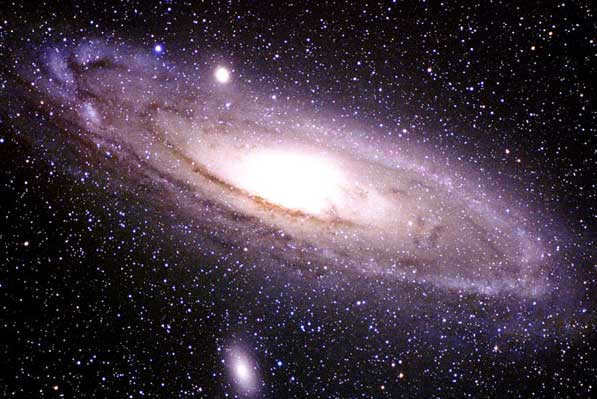
When you set yourself the goal of observing the Andromeda galaxy in the night sky with maximum clarity and detail, there are a few simple recommendations you should follow. First and foremost, it is important to choose a clear, cloudless day for your observations, ensuring that the evening sky remains completely unobscured. Additionally, it is advisable to select a location that is free from strong urban lighting. Many amateur astronomers find it challenging to view numerous stars and cosmic objects due to the bright city lights that illuminate the sky at night. However, the galaxy closest to our own Milky Way is still visible to the naked eye.
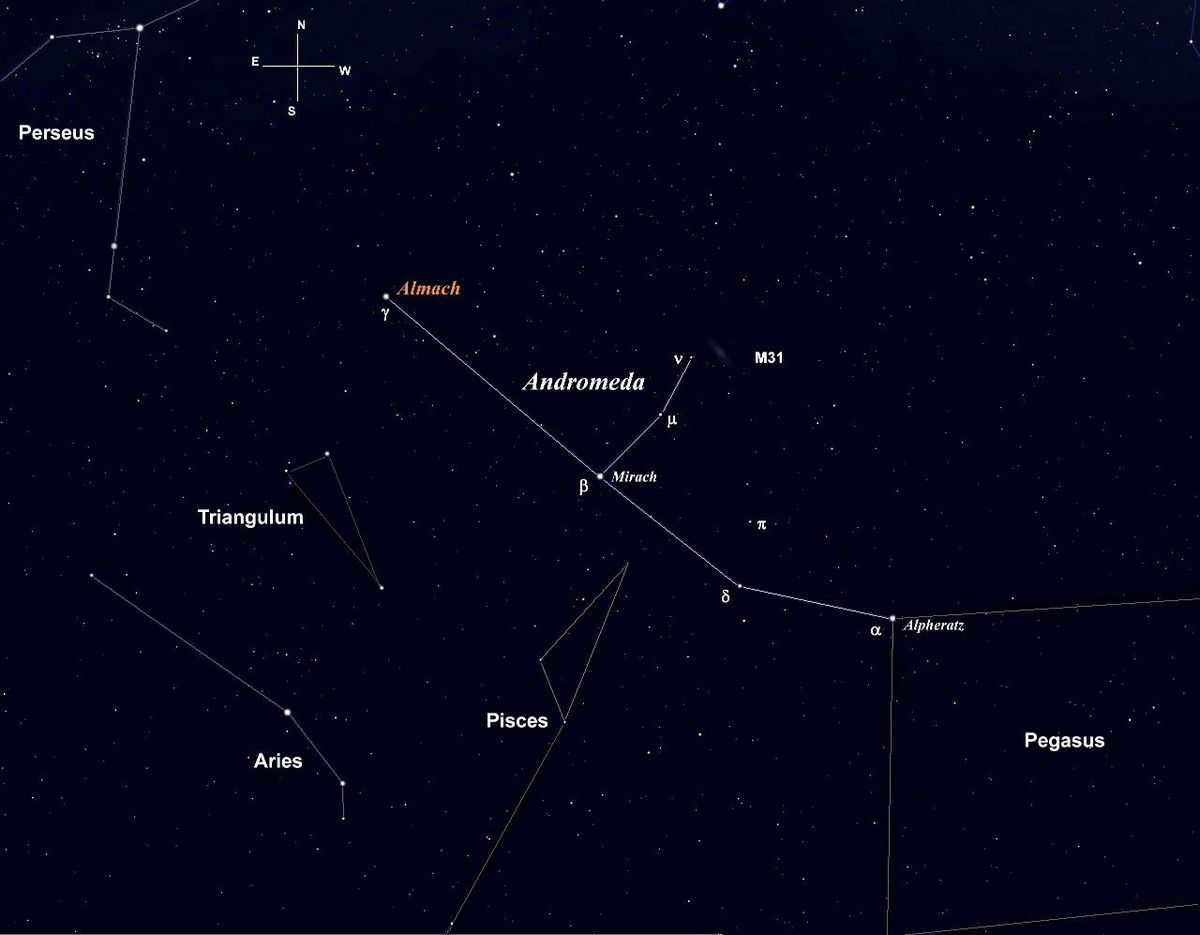
The Andromeda Galaxy, also known as the Great Andromeda Nebula or the Andromeda Spiral Galaxy, and referred to as Monsieur 31 (M31) in the realm of astronomical galaxy classification, has served as a wellspring of inspiration for astronomers, science fiction authors, and, more recently, computer game developers. In fact, there is a remarkable science fiction game called Mass Effect Andromeda, which revolves around the hypothetical journey of future humans to our neighboring galaxy, Andromeda. Yes, you read that correctly, Andromeda is our closest large galaxy and a mere stone’s throw away from our Milky Way. However, despite its proximity, the distance between Earth and the Andromeda galaxy is not insignificant, amounting to a staggering 2.5 million light years. This means that the celestial glow we observe in the night sky from Andromeda originates from a source that existed 2.5 million years ago.

The legendary figures Perseus and Andromeda, after whom the galaxies were named, have been the subject of fascination for astronomers over the years.
Over the course of centuries, numerous astronomers have made note of Andromeda. In 964, the renowned Persian astronomer Abdurahman al-Sufi wrote about this celestial wonder, endearingly referring to it as the “Little Cloud”. Then, in 1780, William Herschel observed Andromeda through his telescope and formed the belief that it was much closer to us than previously thought.
In 1887, Issac Roberts, a Welsh astronomer, captured the first photograph of the Andromeda system. However, at that time, he mistakenly believed that it was a part of our Milky Way galaxy. It wasn’t until the early 20th century that it was realized that the Andromeda system is, in fact, its own separate galaxy with its own set of stars. American astronomer Heber Curtis made this discovery in 1917 when he observed the Andromeda Nebula and noticed that the stars within it were significantly fainter compared to other areas. He estimated that they were located approximately 500,000 light-years away. Additionally, Curtis was a pioneer of the hypothesis of spiral nebulae, also known as “the hypothesis of island universes”. This hypothesis suggests that spiral nebulae are distinct and complete galaxies.
Experimental confirmation of Curtis’s ideas occurred in 1923, thanks to the efforts of another esteemed American astronomer, Edwin Hubble, who constructed his renowned 100-inch telescope. It was Edwin Hubble who initially computed the precise distance to the Andromeda system – approximately 2.5 million light years, and it was he who definitively demonstrated that our Universe comprises numerous galaxies, rather than solely the Milky Way (which had been previously hypothesized). Furthermore, Andromeda is merely one of the innumerable galaxies scattered throughout.
Snapshot of the Andromeda Galaxy
A small image capturing our celestial “neighbor” in the vast expanse of the Universe
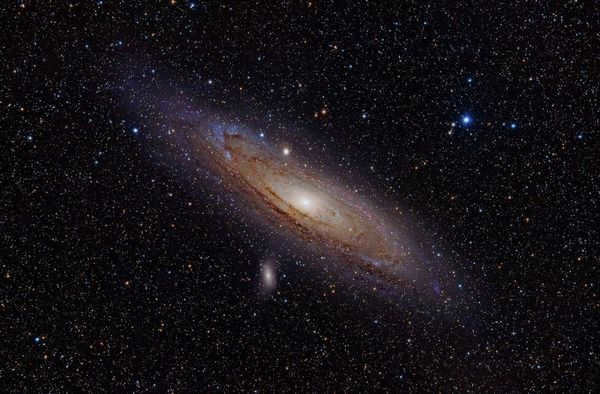
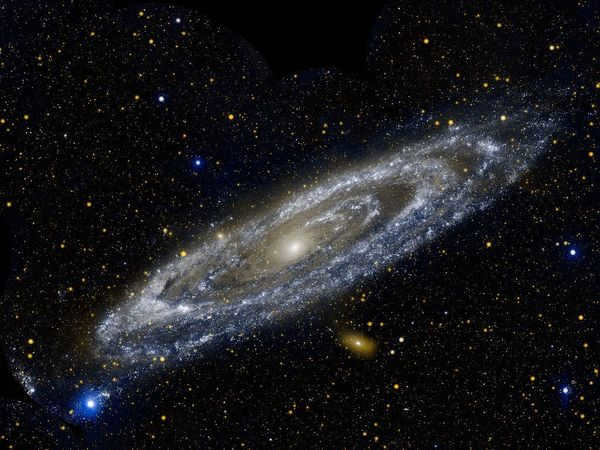
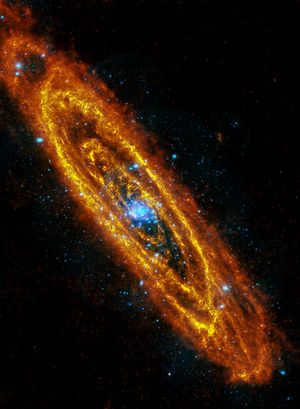
The Andromeda Galaxy and the Milky Way
The Andromeda galaxy is significantly larger than our home galaxy, making it the largest galaxy in our part of the Universe. It contains about one trillion stars, while the Milky Way is comparatively “poorer” with only three hundred billion stars. In terms of length, Andromeda also far exceeds our galaxy, stretching for 260 thousand light years. To put this in perspective, the Milky Way is only one hundred thousand light years long. Andromeda also surpasses our galaxy in terms of the number of satellites, with scientists having identified over 30 of them.
What’s really fascinating is that the Andromeda galaxy is approaching us at a relatively high speed of 100-140 kilometers per second. This means that in approximately four and a half billion years, the Milky Way and the Andromeda galaxy will actually collide, resulting in the merger of the two galaxies into an even larger one. However, there’s no need to worry because our planet, and our solar system as a whole, is unlikely to be negatively affected by this collision. The chances of two stars colliding during a galactic merger are extremely small due to the immense size of these galaxies. In the worst-case scenario, our solar system might be flung into intergalactic space by powerful gravitational waves, but it will remain unharmed.
This image illustrates the impending collision between our galaxies.
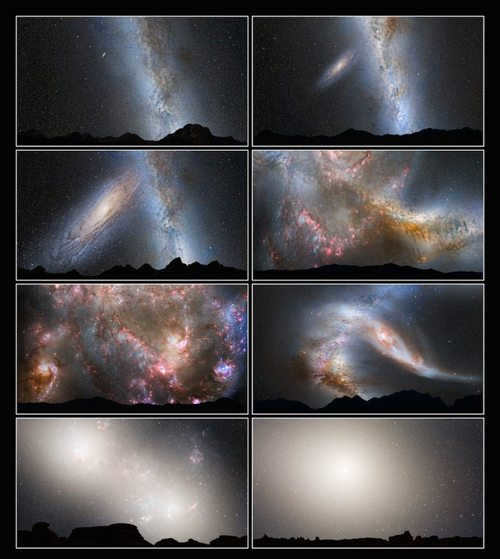
The potential existence of intelligent life and planetary systems in the Andromeda galaxy.
At this juncture, we depart from the realm of established scientific knowledge and venture into the realm of speculation and hypotheses. Given the vastness of the Andromeda system, with its multitude of stars and even more planets, it is plausible, at least from a probabilistic standpoint, that among these numerous planets there could be some that are conducive to sustaining life. If this is indeed the case, then it follows that life may have emerged there, not just in the form of basic organisms, but also in the form of highly intelligent beings. For now, all we can do is speculate and let our imaginations run wild when it comes to envisioning the inhabitants of the Andromeda galaxy.
Once again, in the Mass Effect Andromeda video game, the characters from the Andromeda galaxy are depicted as humanoid beings who share similar physical characteristics with humans – two hands, two legs, and one head. However, it is important to note that intelligent life in the Andromeda galaxy may exist in various forms.
Locating the Andromeda Galaxy in the Night Sky
If you are interested in spotting the Andromeda galaxy with the naked eye, it is actually quite achievable. The most optimal time to observe the Andromeda galaxy is during the months of October and November. To start, you should locate the constellation Pegasus in the southern part of the night sky. About halfway between the horizon and the zenith, you will notice a prominent square shape formed by four stars of similar brightness. This square represents the brightest and most visible section of the Pegasus constellation.
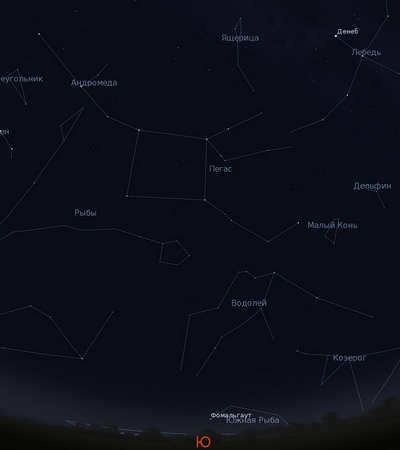
A group of celestial bodies arched upwards connects to the quadrilateral on the left, creating a shape that vaguely resembles a container with a handle. The stars that make up the handle, including the star located at the top left corner of the quadrilateral, are part of the Andromeda Galaxy.
Andromeda Galaxy, video
And now, I present to you an intriguing and educational video from the Discovery Channel that explores the impending collision between the Andromeda galaxy and our own Milky Way galaxy.
According to ancient mythology, many of the constellations that we are familiar with today are representations of significant events from the past. In order to honor their achievements, powerful gods immortalized heroes and mythical creatures by placing them in the night sky. These celestial drawings serve as a reminder of their accomplishments or, in some cases, as a form of punishment for their wrongdoings. One such constellation that holds great significance is Andromeda. While it is renowned for its mythological tale, it also serves as the home to the famous neighboring galaxy, the Milky Way, as well as several other fascinating celestial objects.
Legendary storyline
Andromeda, as told in ancient Greek mythology, was the daughter of King Cepheus of Ethiopia and his wife Cassiopeia. The legend surrounding the constellation has multiple versions. According to one version, Andromeda’s incredible beauty stirred jealousy among the sea nymphs known as Nereids. They wilted in despair as they watched her radiance. In an attempt to remedy the situation, Poseidon unleashed a fearsome beast upon Ethiopia. This creature would come ashore each day, wreaking havoc by destroying villages and claiming lives. Seeking guidance, Cepheus turned to the Oracle and was told that in order to halt the catastrophe, Andromeda must be sacrificed to the monster. Despite their sorrow, the parents dutifully bound their daughter to a rock, awaiting the arrival of the beast. However, tragedy was averted when Perseus, passing by, instantly fell in love with Andromeda and came to her rescue. Using the power of his wits and his trusty weapon, he vanquished the monster and married the beautiful maiden. From that moment on, Perseus and Andromeda have been shining brightly in the heavens above. The gods have also immortalized Cassiopeia, Cepheus, and even the sea monster in the vast expanse of space.
Andromeda is known for its distinct configuration: three clusters of stars that spread out from a central point. This celestial arrangement spans a vast expanse and is among the largest in both the northern and southern hemispheres. The brightest star in the Andromeda constellation, the point where the clusters originate, lies on the border with the Pegasus constellation. Prior to the 17th century, this star was thought to belong to both celestial formations. It serves as the northern vertex of the Great Square of Pegasus.

In Russia, Andromeda can be observed from various locations. During the summer and September, it can be seen in the eastern part of the sky, while in late autumn and early winter, it is visible in the southern region.
Alpha
The most prominent star in this constellation is Alpheratz (Alpha Andromeda). Its inclusion in the constellation was officially recognized in 1928. Previously, Alpheratz was considered a part of Pegasus according to Ptolemy. The name itself has an interesting origin, as it translates to “the navel of the horse” in Arabic.

Alpheratz is a subgiant star that emits 200 times more light than the Sun. It is also part of a binary system, with its companion being 10 times less luminous.
Alpheratz A is a notable example of a mercury-manganese star, known for its high concentration of metals in its atmosphere. This phenomenon is attributed to the gravitational and internal pressure effects of the star on different chemical elements.
Additionally, Alpheratz is classified as a variable star, with its brightness ranging from +2.02m to +2.06m. These variations occur with a period of 23.19 hours.
Galactic cloud

Andromeda is a well-known constellation, not only for its size and beautiful stars, but also for being home to the M31 galaxy. This famous neighbor of the Milky Way is one of the few galaxies visible to the naked eye. Situated just above the star Mirach (beta Andromeda), the Andromeda Nebula can be observed with binoculars, revealing the intricate structure of the galaxy.
The Andromeda Nebula is more than twice the size of our Milky Way and houses approximately 1 trillion stars. Additionally, it has two nearby satellites: the galaxies M32 and NGC 205. The distance from the Sun to these three objects exceeds 2 million light years.
In 1885, the constellation Andromeda caught the attention of numerous astronomers, as it unexpectedly illuminated with a burst of light. This event marked the discovery of the first object of its kind outside of the Milky Way. The supernova S Andromeda resides within the galaxy of the same name and remains the only cosmic body of its kind within it. On August 21-22, 1885, the luminary reached its peak luminosity, measuring 5.85 m. However, within six months, it diminished to a magnitude of 14 m.
Presently, S Andromeda is classified as a Type Ia supernova, despite its distinctive orange color and light curve that deviate from the typical characteristics associated with such objects.
The Andromeda constellation, images of its constituent objects, and the depiction of the nearby galaxy are frequently featured in the media. It is not surprising because the expansive expanse occupied by this celestial pattern can reveal much about the laws of space and the interconnectedness of its various components. Numerous telescopes are directed towards this region in the anticipation of acquiring fresh insights into remote entities.
Despite being located 2.54 million light-years away, it still appears as a 3.44 magnitude star and has a size of 3.167×1° in the night sky, making it visible to the naked eye as a slightly elongated spot. This is because Andromeda contains over a trillion stars, making it at least 2.5 times larger than any other galaxy in the Local Group. However, despite its vast number of stars, it is still dimmer than approximately 150 stars in both the northern and southern hemispheres of the night sky.
Observation
The Andromeda Galaxy can be located in the constellation with the same name. However, it is recommended to begin the search from the constellations that are more easily identifiable and navigable, such as .
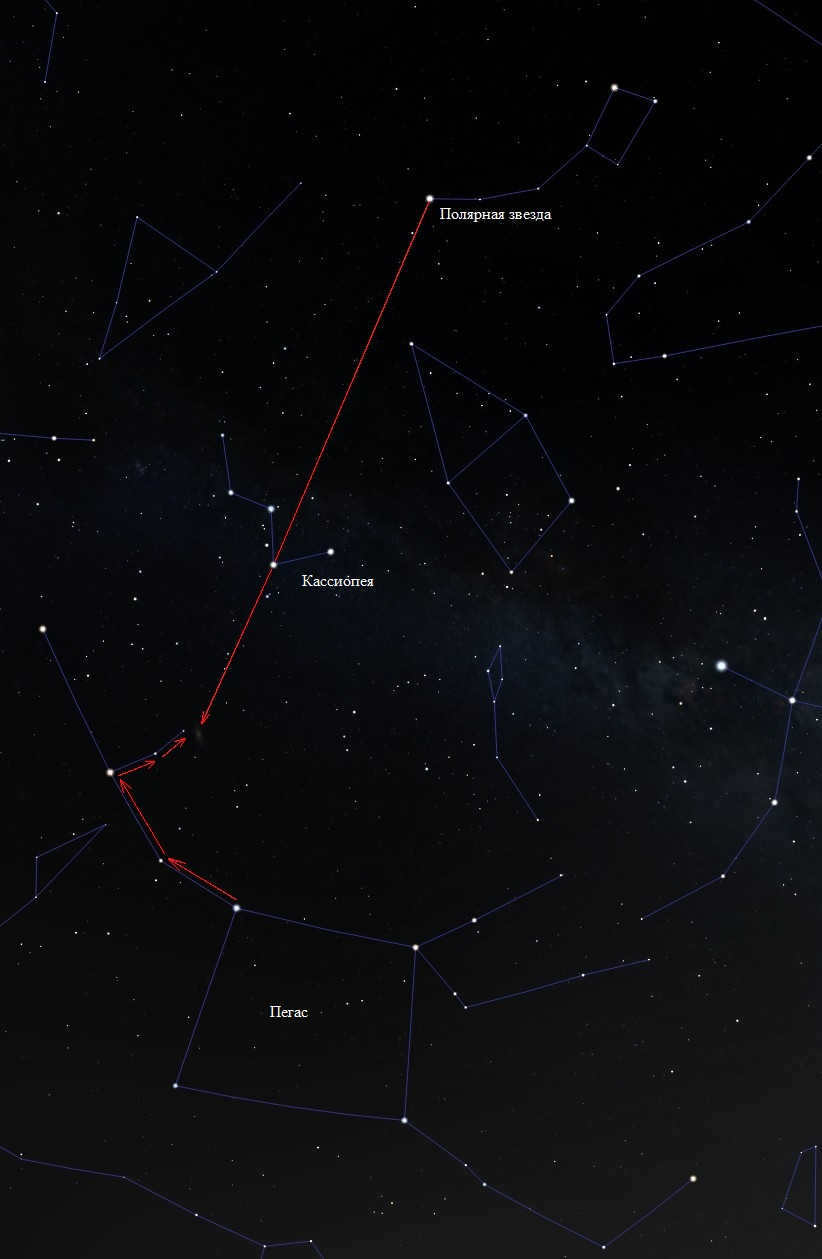
The constellation Pegasus: To locate Andromeda, start by finding Alferats, the brightest star in the constellation Andromeda, which can be found along the continuation of the Pegasus constellation. From Alferats, move to Mirach and then turn 90° to locate two other bright stars in the constellation. Andromeda will be just beyond the second of these stars.
The constellation Cassiopeia: Another method to find Andromeda is by starting from Polaris and locating the constellation Cassiopeia, which resembles the letter M or W in the sky, depending on its position. Along the extension of the line connecting Polaris and Cedar, which is the second star to the right of Cassiopeia, Andromeda galaxy can be found at a distance that is slightly more than halfway between them.
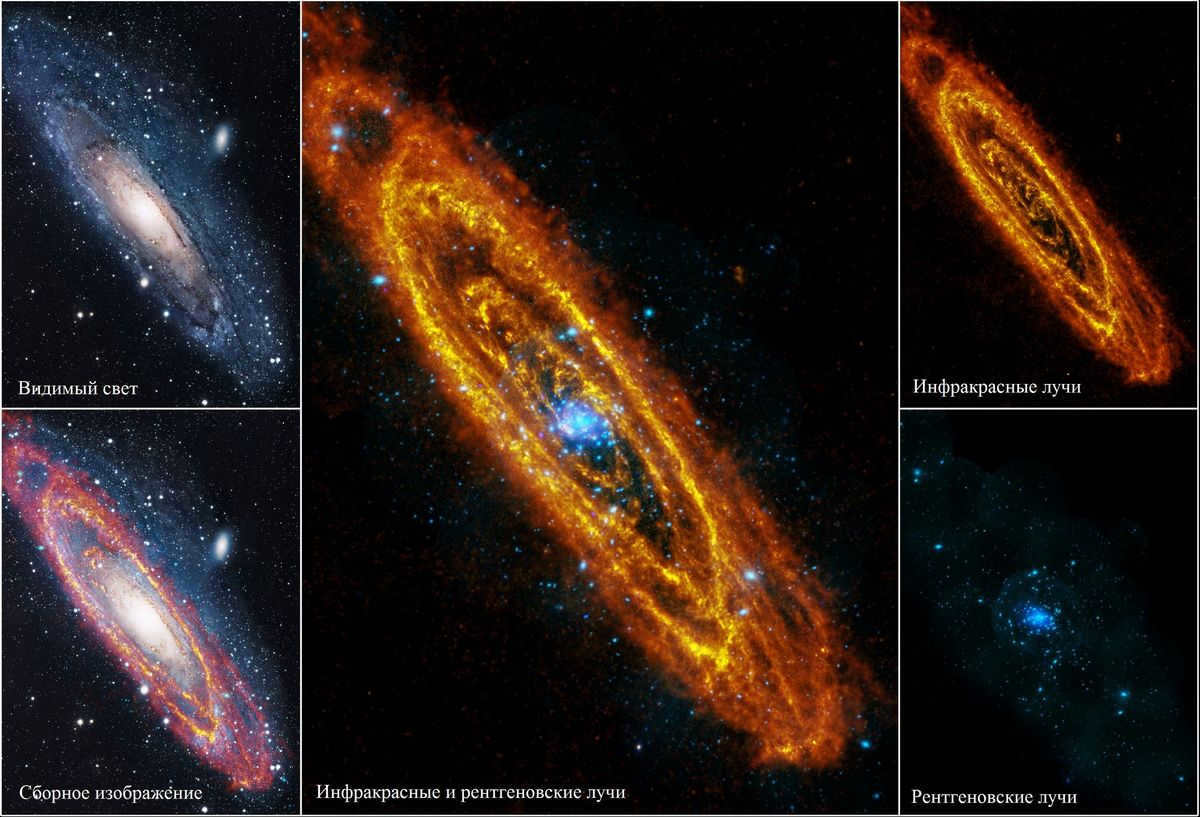
Historical Observations
Dating back to 946 AD, mentions of the Andromeda galaxy can be found since it is visible to the naked eye. However, it wasn’t until the development of advanced telescopes that individual stars within the galaxy could be distinguished. Prior to this, the true nature of Andromeda remained hidden, disguised as a small nebula within our own galaxy. In 1912, spectral analysis revealed signs of its extragalactic origin, showing that it was moving towards us at a speed of 300 km/s. The first estimate of its distance, approximately 500 thousand light years, was obtained through the registration of a supernova explosion in 1917. It wasn’t until Edwin Hubble’s work that the scientific community reached a consensus on the matter.

The Andromeda Nebula is a unique spiral galaxy that can be easily observed in the night sky without the need for any optical devices. It is the only galaxy, apart from our own, that is clearly visible in suburban areas. To get the best view of the Andromeda Nebula, it is recommended to choose dark, moonless autumn evenings. During this time, the galaxy appears high in the sky, where the atmosphere is clearer and the light pollution from cities is minimal.
When it comes to deep space objects, the Andromeda Nebula stands out as one of the brightest and largest objects visible in the autumn sky. So, how can you locate this magnificent galaxy during the fall season?
There are two classic methods to find the Andromeda Nebula in the night sky.
Method No. 1: Beginning from the Pegasus Square
In the summer sky, the main star pattern is the Summer Triangle, but in the fall, it is replaced by another group of stars known as the Great Square of Pegasus. The Great Square of Pegasus, also known as the Square of Pegasus, can be found in the southeast, to the left of the Summer Triangle after sunset. By midnight, it will be located in the southern part of the sky. Look for this quadrangle, which consists of stars that are similar in brightness to those in the Big Dipper, visible in the north at this time.
The Summer Triangle and the Square of Pegasus in the fall sky. Figure: Stellarium
Adjacent to the square on the left, there is a sequence of three stars that have a similar level of brightness. The sequence curves upwards, giving the appearance of a large coffee pot in the Pegasus constellation. These stars are part of the Andromeda constellation.
Now, focus your attention on the middle star in the sequence, or more specifically, its surrounding area. Above it, you will notice two fainter stars. This is actually a good test. If you are able to confidently see these stars, there is a high chance that you will be able to see the Andromeda Nebula as well. On the other hand, if you struggle to see the two stars, it indicates that the sky’s quality is not optimal. In order to spot the Andromeda Galaxy, you will need to use binoculars or a telescope (which is perfectly fine, as not everyone has access to them!).
So, we have one final step remaining. The second star, known as the Andromeda Nebula, is positioned just above and to the right of the Andromeda Nebula itself.
In the Pegasus square, you can find the constellation Andromeda and the Andromeda Nebula (which is circled). Image: Stellarium
Method #2: Starting from the Cassiopeia constellation.
The Cassiopeia constellation is easily recognizable due to its distinct pattern, resembling the letter M or the Latin letter W. This small constellation is visible in the night sky throughout the year. During the autumn season, Cassiopeia can be observed in the eastern part of the sky during the evening, at approximately 60° above the horizon. At midnight, it reaches its highest point in the sky.
The Andromeda Nebula can be located by starting from the stars of Cassiopeia. Image: Stellarium
Both search options are equally simple. Maybe the initial approach is slightly more dependable, as it provides the position of the nebula directly adjacent to the star. However, you can easily merge the two methods – for example, discover the Andromeda constellation from the Cassiopeia constellation, and locate the Andromeda Nebula using two stars.
Let’s discuss the visual appearance of a galaxy without any aid. In a sky devoid of light pollution, it will appear as a faint, elongated shape approximately half the size of the visible disk of the Moon. No specific features will be discernible. In conditions of average sky transparency, the galaxy might not be visible to the naked eye or may appear extremely faint. In such cases, it is advisable to use peripheral vision. This entails looking slightly away from the location of the Andromeda Nebula while simultaneously attempting to detect its subtle luminosity.
It goes without saying that spotting the Andromeda Nebula is a daunting task in an urban setting. The likelihood of success hinges greatly on the atmospheric conditions and the selection of the observing site. It is advisable to seek out a location that is shielded from the glare of streetlights to the greatest extent possible. It is crucial to avoid observing under the illumination of the Moon. Prior to embarking on an observation session, it is recommended to allow your eyes to adjust to the darkness for approximately 10 minutes. During this interval, it is important to remain in complete darkness. The ultimate outcome hinges on your level of patience, expertise, and the prevailing atmospheric conditions.
Engaging in astronomical observation is an incredibly captivating endeavor that has the potential to captivate individuals of all backgrounds. The vast expanse of the night sky presents an array of celestial objects that can be explored and examined through the use of telescopes, binoculars, and even the naked eye. However, for those new to the world of amateur astronomy, getting started can often prove to be a challenging task. Ideally, having a visible moon or bright planets that stand out against the backdrop of stars is advantageous. But what if these elements are not present? The unfamiliar constellations can be overwhelming, causing the novice observer to quickly lose interest in the night sky.
Many people living in modern cities are unaware of the fascinating sights that can be observed in the night sky without the need for any optical devices! Due to the excessive artificial lighting, we have become accustomed to not gazing at the stars. However, even in urban environments (unless you reside in a bustling metropolis), it is possible to catch a glimpse of faint celestial objects. To accomplish this, the first step is to locate a spot shielded from streetlights. A park, the outskirts of the city, or even a secluded corner of your home would suffice. Once you have found a refuge and allowed your eyes to adjust to the darkness, you will be astounded by how dim stars begin to enter your field of view.
During the mid-autumn period, the night sky in the southern hemisphere is adorned with two prominent constellations: Pegasus and Andromeda. These constellations serve as a great starting point for stargazers who wish to explore the wonders of the universe. Not only are they relatively easy to locate, but they also act as a guide for spotting other constellations that grace the autumn sky. Additionally, the magnificent galaxy M31, also known as the Andromeda Nebula, can be found near these constellations, adding to the celestial spectacle.
To locate the constellation Pegasus, simply direct your gaze towards the southern sky after 8:00 pm. You will soon notice a striking square formation comprised of four equally bright stars, situated halfway between the horizon and the zenith. This square, which is missing its upper left corner, represents the most prominent aspect of the Pegasus constellation. On the left side of the square, you will observe a graceful arc of stars that curiously connects to form a shape resembling a bucket with a handle. These stars, including the upper left star of the square, are associated with the Andromeda constellation.
During the evenings of October, both the Pegasus and Andromeda constellations can be found high in the southern sky. Image: Stellarium
Mid-autumn is marked by the presence of two prominent constellations, Andromeda and Pegasus. As the evening progresses, the sky reveals other constellations, particularly the brighter ones associated with winter. However, during the month of October, Andromeda and Pegasus dominate the night sky.
Andromeda not only encompasses a constellation but is also home to the Andromeda Nebula, a massive spiral galaxy located 2 million light years away from our planet. Surprisingly, the Andromeda Nebula can be observed with the naked eye. While it may be challenging to do so in urban areas, the author of this text was fortunate enough to witness this magnificent sight, even in a city with a population of half a million people.
Looking for the Andromeda Nebula? Begin by locating the upper left corner of the Square of Pegasus. Trace along the handle of the “bucket” until you reach the star Mirach (β Andromeda). Positioned above Mirach, you will notice two dim stars identified as mu (μ) and nu (ν) in Greek. The Andromeda Nebula is situated slightly above and to the right of ν Andromeda.
Above the star Mirach, which serves as the central star in Andromeda’s knob, you will find the Andromeda Nebula. In the illustration, the nebula is depicted as an elongated patch of haze. Illustration: Stellarium
Examine this section of the sky closely. If you don’t initially perceive a faint, cloudy glimmer, attempt to view the area using your peripheral vision. Gently move your head from side to side. If you are able to clearly observe the nu star Andromeda, it is probable that your peripheral vision will detect the movement of the faint spot.

